Australopithecine
Australopithecine |
Australopithecines. (4-1 mya) Ape of South.
- first by Raymond dart 1924 South Africa taung Valley.
- A. Africanus, robustus, afarensis - Lucy.
- Geography.
- Lake chad, hadar, Olduvai. East African
- Sterkfontein. Taung valley. Swartkrans. South Africa.
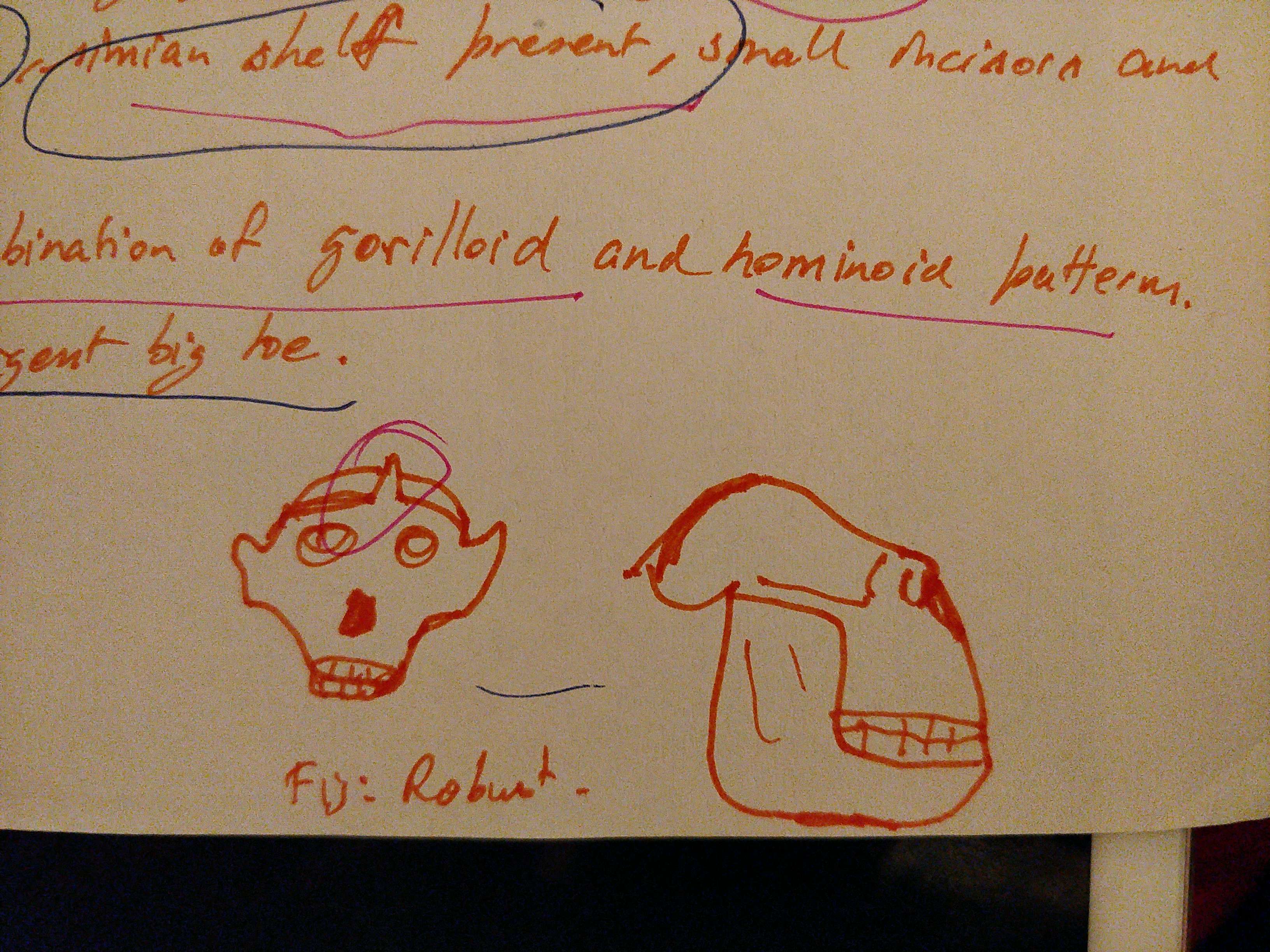
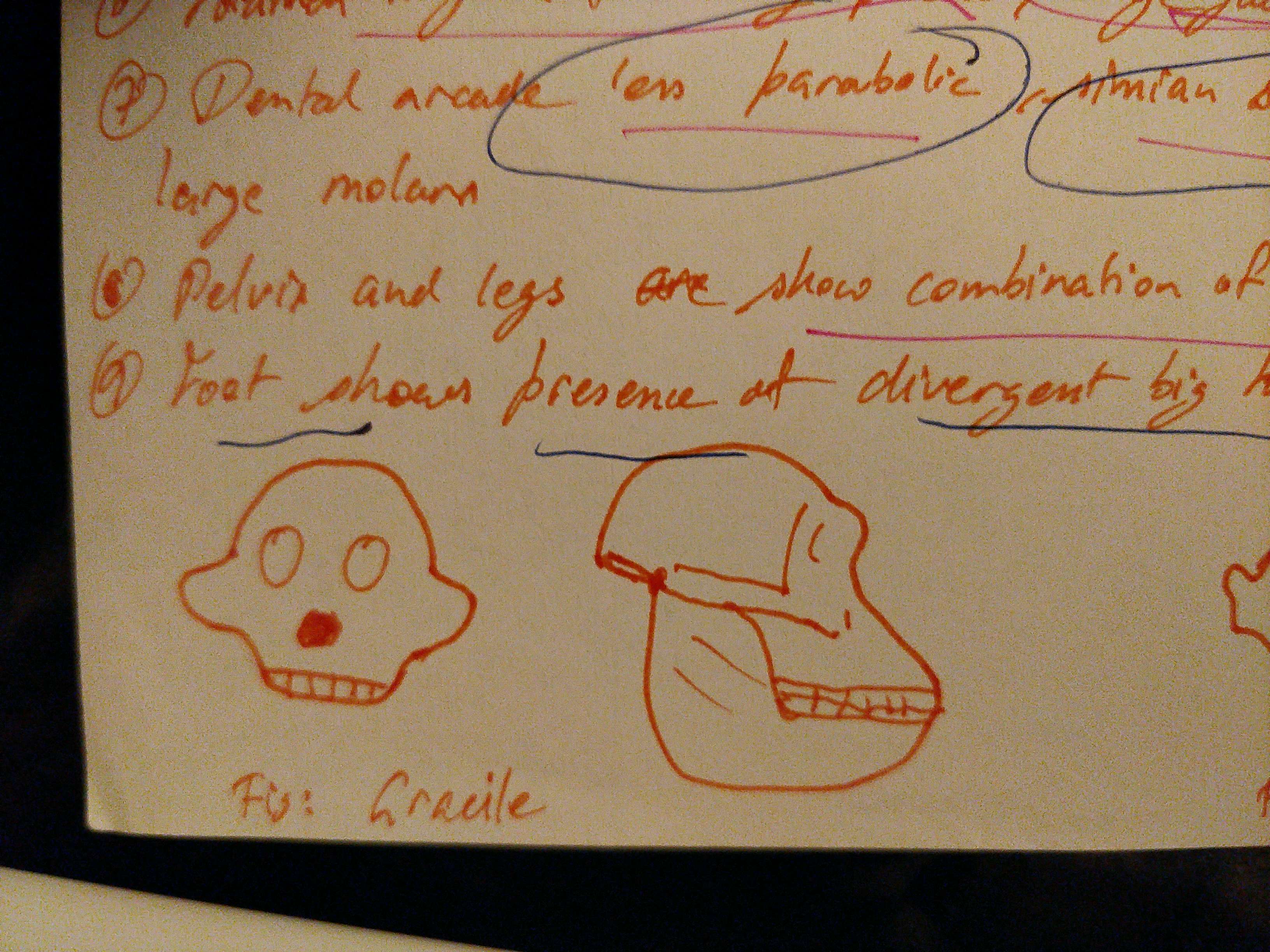
Features. Gracile. 3 to 4ft. 30 to 70 kg. Africanus.
- Primate
- Long arms.
- 400 and 600 cc
- Low and flat forehead but rounded in africanus.
- Brow ridges
- Large jaw
- No chin.
- Man. Like
- Gracile
- Sagittal crest absent.
- Smaller canines.
- Temporal fossa, mastoid process and zygomatic arch developing towards man.
- Foramen Magnum forward.
- Pelvis and legs bipedalism adjusted. Linea aspera.
- Non divergent toes
- Osteo donto keratic culture. R Dart.
- Hunting. Small animals. did not have fire ability yet. Possibly scavenger. Cannot hunt big animals without good tools and group hunting. Cave life.
Features. Robust. Robustus
- 4 to 4.5 ft
- 40 to 80 kg
- Heavy built body. Long arms. Human like in post cranial anatomy.
- 500 and 600 cc.
- Sagittal crest present
- Message zygomatic region and mastoid process not developed.
- Temporal fossa is large
- Large supraorbital region
- Less parabolic dental arcade and simian shelf present.
- Large jaw.
- Pelvis and legs have Gorilla and human features. Divergent toe.
•9 species. vary in robusticity & size.
•Large premolars and molars. Small canines and small brain.
•Phylogenetic. Opinion divided on phylogeny by Donald Johanson and Timothy white two branches theory. Alan Walker discovery led to 3 branch theory.
- Ar. Ramidus. T white. 1994. 4.5mya. 17 fossilsA. anamensis. first australopith. Now controversy as skull discovered. Mrs Leaky 1995 4mya.A.afarensis. Johanson 1975 Lucy 3.2 mya. 1994 13 fossils with adults and juveniles.
- A. garhi
- homo or not ?
- A. africanus.
- Homo or robustus ? Controversy.
- A. aethipithecus
- robustus or boisei ?
A. anamensis. Land Turkana.
- 4mya.M leaky & A walker. Allia Bay. Lake Turkana. Kenya.
- similar to ardipithecus.
- Primitive characteristics like
- large canine
- parallel tooth row in upper jaw not parabolic.
- Lower third premolar with large outercusp & small inner cusp. Woodland ecosystem.
A. afarensis. Hadar. Laetoli.
- 3.6- 3 myaLaetoli Tanzania. Hadar, EthiopiaLucy
- 1m height.
- short legs than trunk and arms.
- males 1.5 m.
- brain like chimpanzee.
- shoulder similar to modern man.
- phlanges same as human length but curved.
- traces of arboreal suspensory locomotion.
- glenoid fossa slightly tilted than man = climbing abilities.
- Mosaic of human and ape features.430 cc. hyoid bone like apes. no speech possible. larger canines.
- two cusps of third premolars are more equal in size = more human like.
- canines smaller than earlier
- parabolic tooth row.
- round heels. double arches in foot. non divergent toes.
- Laeoteli footprints. bipedalism confirmed. Habitat forest Woodlands and open country. Diverse diet.
A. or Kenyanthropus platyops
- Flat fac
- Diversification of homininae. 3-1 mya
A. garhi. 2.5 mya = surprise
- Berhane Asfaw found this species in Ethiopia middle awash region, Bouri. 1999bones, teeth, partial skeleton and skull. Teeth larger than australopithecine. Third premolar cusps were almost equal in size. Beneath the nose face had primitive projection and brain size was small 450 cc. Ratio of humorous to the FEMur was human like. Femur was longer. Lake side life.First tool use.
- 3.3 mya to 1.6. Oldowan complex. First hominin culture. Au. afarensis or platyops. Au garhi by Desmond Clark cut marks at mammal bones. australopithecus also had flexor muscle in the thumb which allows better precision. Therefore tool use possible.
Au. africanus
- Raymond dart found at Taung site. Also sterkfontein dated 3 and 2 million years ago.
Extinction of australopithecine
- Au aethiopicus. Au boisei. Or paranthropus.
- Au. aethiopicus Found 2.5 million years ago 410 CC brain and old y gorge around lake turkana.
- Au boisei. Lake turkana 510 CC brain 2 tell1 million years ago.
- Smaller front teeth, larger back teeth, larger faces, well developed sagittal crest. enormous molars and premolars. Chewing muscles are very strong.
- Au or Pa. robustus. 2.0 till 1.5 mya. And Au sediba 2mya. Ate hard foods. C4 grass. 80% grass diet.
- Lee Berger. Au. sediba - Jo face and teeth are relatively small. Cybermatics do not fair outwards. Broad pelvis and oval shaped human like. small body and long arms like australopithecine. large fingers and powerful muscles for arboreal setting but long-term for precision gripping and tool production. Brain size 420 cc ee smaller than early homo. May have played role in our ancestry.
Chalcolithic |
Copper stone age.
- Marked by emergence of metals like copper and later enjoy with bronze.
- Earliest 6000 BC zagros mountain Iraq. 5000 BC between euphrates and tigris sumerian
- Tools and Technology.
- Agri. Plough and hoe
- Warfare. Helmet Shields swords battle axe culture.
- Alloy making 2500 BC Czechoslovakia copper and tin = bronze.
- Regional variation in India
- The Neolithic trend of using polished stone tools continued in this period also.
- Microlithic tools on silicious material were very common.
- Copper and its alloys were used in making axes, chisels, knives, fishhooks, pins, rods, etc.
- Stone grinders, mullers and hammers were used for processing food
- Pottery used to be decorated with linear, curvilinear and intricate designs in black pigment.
- Floral, vegetal, anima, bird and fish motifs were also used in the decorations.
- Adults buried in extended position.
- Female figures from newasa and inamgaon.
- West India
- Distinct urban growth 2700 and 1600 BC
- Mehergarh. Pre to post harappans
- Rest India
- Very rated village structure with copper bronze iron from 2300 and 1100 BC.
- Bihar Orissa Bengal. copper age villages with tiny celts, microlith and wheel made red and black pottery with copper.
- Chirand bihar. Pandu rajar dhipi WBengal.
- South India. Tributaries of Krishna river. Deccan chalcolithic. Hill dwellers with peripheral cultivation of ragi and millets. Bury in East West. Urns at home.
- Cultures
- Ochre colured pottery
- Upper Gangetic basin. B B Lal 1951
- Atranjikhera.
- Copper hoards.
- Tools. Rings, flat and shoulder celts. Anthropomorphic. Swords. Double edged axes. Harpoon.
- Sedentary life. Domesticated animals cattle. Rice and Barley growth.
- Some call it free hadapan hadapan and late Harappan stages.
- Kayastha 2000 to 1800 BC
- Wakhankar 1964. Tapi Narmada basin
- Pottery is fine. Wheel made. Linear painting design.
- Axes. Ornaments like bangles necklace beads
- Houses made of mud and bamboo
- Ahar. 2000 to 1400 BC
- Agrawal. Rajasthan Ajmer.
- Black and red ware pottery
- Flat copper celts.
- Housing of stone and mud. Un-baked bricks also found
- Economy agriculture and animal husbandry
- Malwa. 1700 to 1200
- Navdatoli by Sankalia. MP
- Light red and pink in black pottery
- Tools. Celts, hooks, daggers.
- Wooden post houses circular or rectangular shape.
- Agriculture. Barley gram masur. Animal husbandry
- Jorwe. 1400 to 700 BC
- Maharashtra. Amravati daimabad nevasa
- Cultivated Barley wheat rice
- Copper axe, needles, bangles.
- Artificial irrigation
- Absence of dishes indicates semi liquid food preparation.
- Red Orange matt surface painted in Geometric design on well baked fine fabric pottery
- Burial. Facing north extended position. Children in urns
- Female figurines. Social hierarchy possible with better huts at the centre.
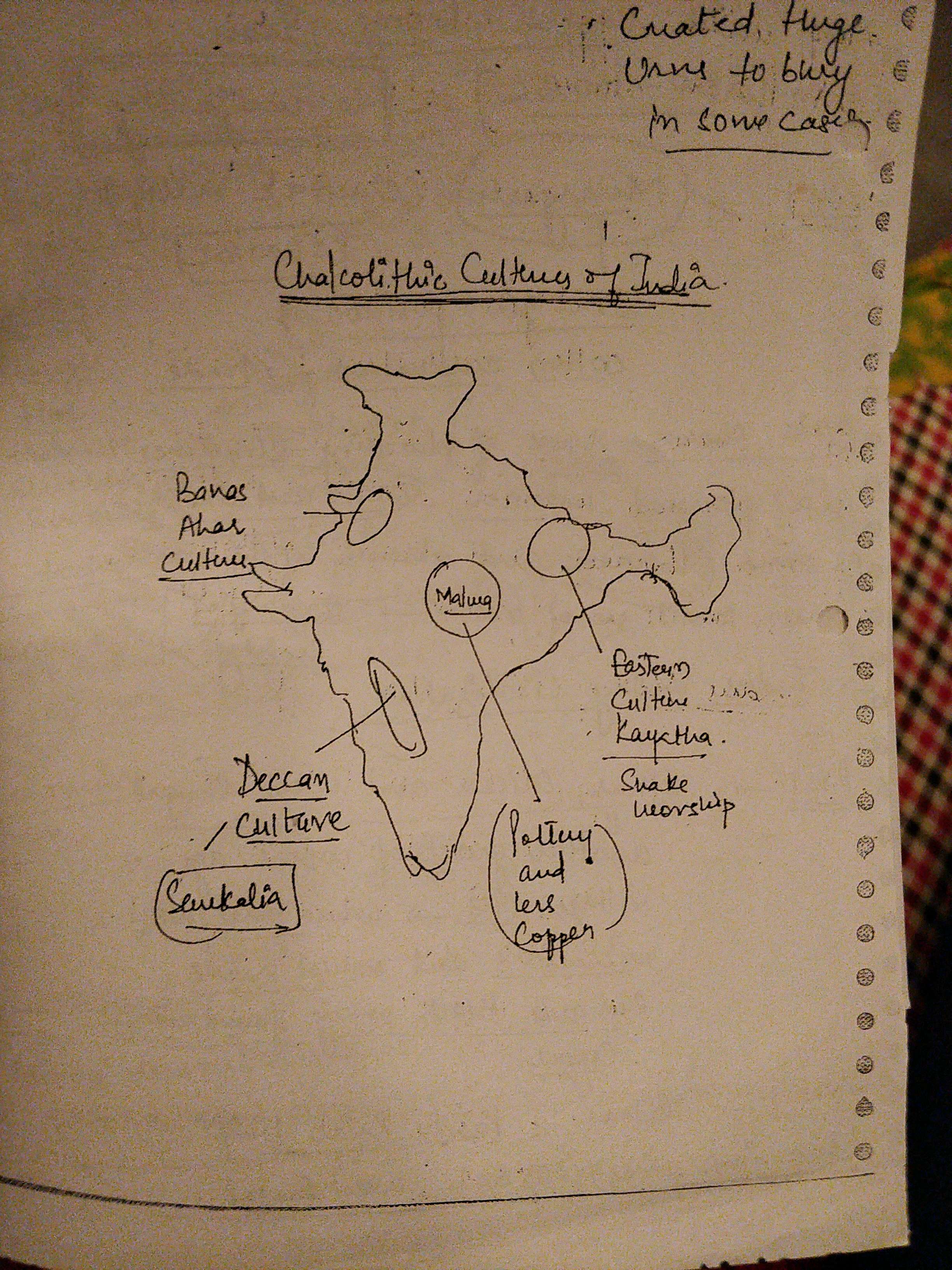
Iron age |
Iron age
- Second urbanization. Social stratification. Literary record.
- Scholars disagree on chronology but thousand BC and 100 is the usual range. Roy & Ghosh disagree.
- painted grey ware and northern black polished ware. South India it is megalithic structures.
- Variation
- North India. Painted grey ware and northern black polished ware.
- 800 to 400 BC. Pgw phase. Most common is black and red ware and Red ware.
- painted grey ware because firing in reduction absence of oxygen condition and painted with black. Deluxe pottery.
- Iron tools for weapons for hunting mainly but very few for agriculture and household tools. Copper continuous for tool use and ornaments. Glass bangles and beads
- Wattle daub houses.
- Stone bone clay shell ivory tools and crafts. Subsistence practice of cultivating rice domesticating horses cattle buffalo sheep.
- 2nd phase 600 bc and 300 ad. Early historic phase. Northern black polished ware. material culture like ring well, baked bricks, fortifications, coinage, beads. Empires.
- More use of iron as tools. Urbanization. State societies.
- Painted grey ware associated with later Vedic society. Reconstruction using literature Buddhist and Vedic to construct social dimensions. May have chiefdom society with some stratification and later period increased stratification with emergence of chief based on territory ritual specialist brahmins and shudra. Varna system. Buddhism emerged Jainism. Ajivika sect Vedic philosophy schools. Trade guild.
- Peninsular India. Megalithic.
- located in forests for wastelands. Range from small clusters to large areas like adichanallur
- Unusual megalithic structures from Kerala. Umbrella or head stone found made of local letter write material.
- Urn burial in Tamil Nadu Madurai.
- Sometimes Terracotta sacrophagus is used.
- wide diversity in megalithic structures. Pottery is also associated with grave goods and can be black and red ware, black, red where and regional in origin. iron objects are iron bands, arrowheads, sword, spike, cycle, nice, blades. Copper was also used
- Stratification. Brahmagiri has few burials with no iron objects and very few pottery. Other side has 33 gold objects copper bangles.
- Central India. Malwa and Ahar
- Lower Ganga valley. Chirand and Sonpur.
Prehistoric Art |
Prehistoric art
- Joordens 2015. Sale marks created by Java H erectus. 500kya
- Venus of Tan Tan Morocco. 300kya. R bednarick believes art may be older than we think
- But large scale creative explosion happens in upper paleolithic. noam chomsky thanks that it has something to do with sudden development of language in the modern form.
- Artworks in in caves and rock Shelters with paintings. Open sites creation on boulders.
- Upper paleolithic. Bhimbetka caves. Red white green colour used to paint elephants rhino tiger. Geometric patterns. Green paintings of dancers and read for hunters. Kurnool too.
- Mesolithic paintings. Paintings become smaller. More natural district. more style in painting human role. Women children men in different roles like hunting gathering dancing.
- Chalcolithic. show relation with agriculture communities and under gatherers. Paintings are storytelling. Very good quality and increased realism. Home art also seen. More art on wall objects like ivory stone pwntools animal teeth.
- Czech republic as ivory locket engraving on animal bones. Venus figures. France lacaux paintings. Geometric design on pottery.
- Function point expressing creative urgent. Educational purposes. Rituals. Worship. Sexual fantasy.
Lower Paleolithic India |
Lower paleolithic India
- 1.7 mya attirampakkam to 172 kya. Approx.
- Climate. Pluvial cycles and glacial cycles.
- Core Tools. Hand axe, chopper chopping, cleaver, pebble. Acheulean type. Direct percussion technique. Stone hammer.
- Species. H erectus.
- Regional variation
- Bhimbetka. Raisen district MP. Discovered by v s wakankar 1962. Cave III F 23 studied by AVN Mishra 1966. 8 layers. 3 lower 1 middle 1 upper 3 meso.
- No chopper chopping tools. No abbevilian handaxes.
- OS Damoh and Adamgarh.
- Soan. DeTerra and Patterson. 1935. Quartzite Pebble early chpper chopping. Hand axe, cleavers and choppers of Acheulean tools in chauntra. OS Pinjore and Kashmir sites.
- Attirampakkam. Madrasia. Brucefoot 1863. Quartz Abbevilian and acheulean Handaxe cleaver culture. Low frequency of chopper chopping tools. Cleavers with narrow waist - possible hafting earliest. S Pappu and Akhilesh push back dates. OS Nagarjunaconda and Hunsgi
- Didwana. Jodhpur. Mishra 1980. Chopper chopping and massive handaxes. Later, choppers with handaxes and Cleavers absent. OS Chittorgarh and Sabarmati valley. Riverbank occupation with humid climate and thinning of human colonies.
- Kuliana and Kamartoda. Mayurbhanj. Burhibalang river. Chopper chopping with acheulean and abbevilian handaxes. Cleaver with pebble butts. OS Singhbhum and Kamarpada.
- Social life. Hunting gathering economy. Use of fire. Cave dwelling.
Neanderthal |
Neanderthal
- Man of neander Valley. 1850s
- 430kya to 30kya.
- Species. Classic from Europe. Progressive from Mount Carmel.
- Geographical distribution
- Neander valley Germany
- Miguelon Spain
- Mt Carmel Israel.
- Shanidar Iraq
- China. Libya.
- Features
- Cranial capacity 1700 cc.
- No chin
- Dolichocephalic
- Skull wall and browridge thick
- Parabolic dentition no diastema
- Some prognathism
- Long femur with large head
- Heavily muscle thick neck
- Strong ribs
- Foraman magnum similar to humans
- Erect poster
- Robust build
- Used medicinal plants. Karen Hardy.
- Culture
- Flake tools Mousterian.
- Levallois technique. Requires significant thinking in the future.
- La Chapelle man would not survive without cultural support
- Ritual evidence of deliberate Teshik Tash burial in uzbek. Surrounded by goats. At shanidar floral offers at grave.
- Existence of language and foxp2 gene.
- Hyoid bone of kebara Fossil identical to man.
- Possibly used symbols as Marine shell ornaments observed by Zilhao.
- Needles indicate clothing. Use of fire. Possible near cult in France.
- Nature 2014. Diabetes crohn's disease and smoking addiction may have come from neanderthals.
- Similar features
- Large face. Nasal depression.
- Large screen capacity
- Negroid nasal aperture
- Human dentition
- Fore arm shorter than upper arm
- Upper alveolar broad and deep life australoid
- Face below orbit is straight.
- Occipital bun
- Differences
- Parieto temporal suture straight
- Zygomatic arch is projecting
- General flattening of skull
- Mastoid process not as well developed
- Foramen Magnum slightly backward
- Alveolar region does not merged with nasal floor.
- Fossils coexisted Homo sapiens in Israel which means that may not be possible and sister
- genetic study of y chromosome and mitochondrial DNA indicate they separated six hundred thousand years ago. 25 genetic differences versus 55 with chimpanzee.
- Studies estimate 5% jeans common.
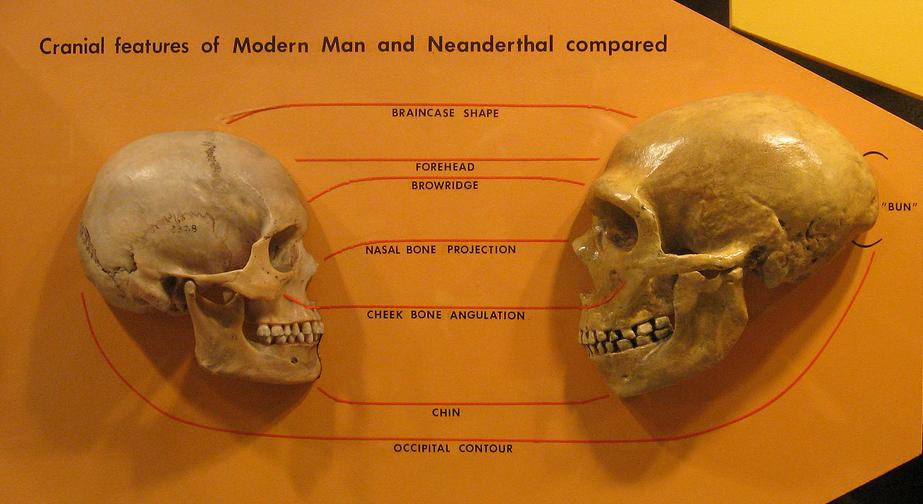
Classic versus progressive neanderthal |
Classic vs progressive neanderthal.
- Cranial capacity smaller. 1600 vs 1700 cc amud fossil.
- Receding forehead
- Large scale but not broad.
- Larger supraorbital ridge.
- Large teeth.
- Rudimental chin.
- Lower cranial vault.
- More maxillary prognathism.
- Femur is bent slightly.
- Robust short and stocky build
- Distributed across best hero. Lachapelle. Vs mt Carmel.
- Stressful conditions with arthritis and 40 year of life.
- More occipital bun.
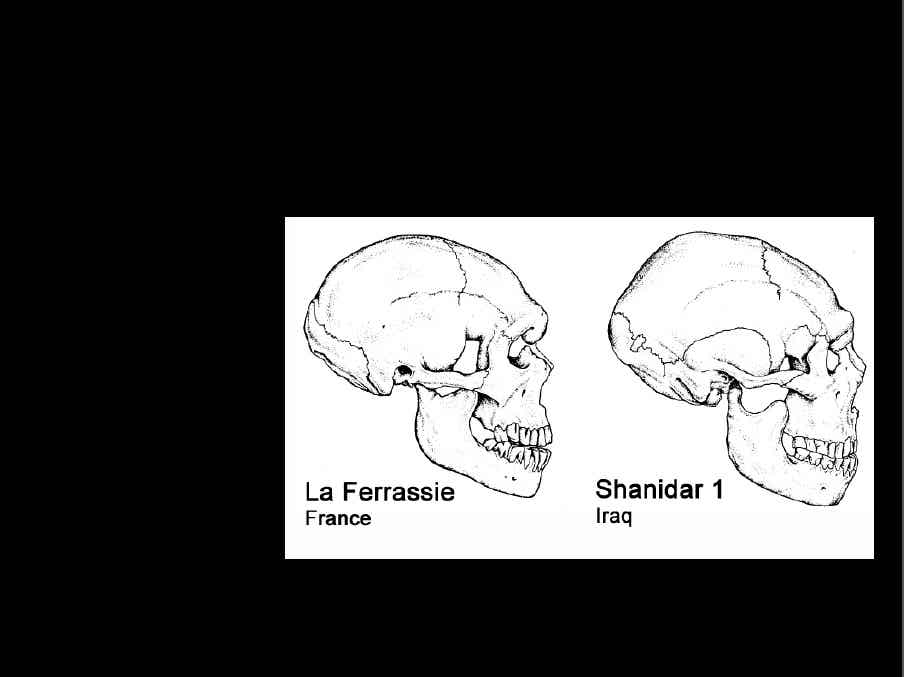
Same post cranial features.
Neo chalcolithic |
Neo chalcolithic 3000 to 1000 BC with variations.
- 1959 Krishnaswamy divided into 4 zones North, East, Central and Western zone, Southern zone.
- HD sankalia 1962 claimed that Central and western and Southern zone don't have your neo lithic or chalcolithic. He called it neo chalcolithic.
- Pure neolithtic. Eastern India with ground axes, very little pottery. Includes Kashmir sites which has ground axes, bone tools pottery and pit dwelling.
- Neo chalcolithic.
- South India. Western Andhra Pradesh Karnataka Tamil Nadu. Ground stone tools, microlithic blades, handmade pottery and round huts on terrace. Pieces of copper found.
- Early balochi culture kilu Gul Mohammed. Hand and wheel made pottery. Ring stones. Saddle and quern. Celts.
- Bagor. Bhilwara. Microlit, copper arrowheads, pottery and huts with wooden posts
- Influenced by local ecology soil climate rainfall temperature rocks.
- Tekkalkotta. Karnataka. 19 small circular hats with 3 to 5 m diameter. Burial under floor of house sometime with the URN. giant boulders near the site have artworks like pecking bruising and paintings with red ochre. Bull deer human are common figures. Domesticated cattle buffalo goat sheep and dog.
- Sanganakallu brahmagiri hallur show similar features. Piklihal of Andhra and payyampally of Tamilnadu similar.
- Scattered habitation. Neolithic axes with saddle corn found in in good frequency. Mysterious ashmounds of cow dung are found which indicates pastoral economy.
- Elchuru. Prakasam district Andhra Pradesh. Excavated by Telugu University. Circular huts and burials. Grinders, querns, celts. Handmade ceramics. Murti studied chenchu tribe to reconstruct the past using ethnoarchaeology.
- Bhattacharya explains on changing culture despite contact with new technology because of
- Site occupied by small holds of mesolithic hunters. Rocky plains which was less forested. Seasonal habitat.
- Ash mound indicates pastoral economy suited to the southern plains of Rocky plane. Scanty rainfall means did not allow intensive agriculture which kept the demography stable and did not necessity any major changes in the tool culture. Ragi
- they may have depend upon other cultures to exchange their forest produce and valuable like today. This explains the presence of gold ring in the area.
- Features
- Poor pottery. Indigenous origin. Copper and bronze objects common. Black and red ware. Horse bone fragments. Terracotta figurines and beads. Trade with harappans possible. Small habitations. Wattle daub houses.
- Blade technology.
- Pastoral economy with cultivation of finger and pearl millets. Dominated by sheep goat cows
- Rectangular house of chief and round hats off common people.
- Bury dead in East West direction. Deposits of copper object at the grave belief in afterlife
- Art of making bangles of copper. Bead necklaces of carnelian and steatite. Trade with Harappan.
Upper paleolithic India |
Upper paleolithic India
- 40kya to 9kya
- Homo sapiens
- Wurm glacial period. Gambian pluvial period.
- Tool material. Bone, stone
- Tools. Blade tools common scraper burin knife, point Tools.
- Cylinder hammer technique.
- Regional variation in India. Geography rocks. Flora and fauna
- Machchatta Chintamani gavy. Kurnool district Andhra Pradesh. Excavated by Murthy. 90% bone tools and 10% stone tools. Blades are not retouched. Bone tools are scrapers chisel scoop. only site with bone tools in upper paleolithic.
- Reningunta. Andhra Pradesh Chittoor district. Mlk murthy. Mainly stone tools like burin scraper points made of olive green quartzite.
- Bhimbetka. Wakhankar 1962. Raisen district Madhya Pradesh. Fourth layer upper paleolithic 6 to 10 centimetre long blade based industry. Several types of scrapers and burin comparable to Western Europe are found. Paintings of various hunting scenes celebrations.
- Belan valley. Allahabad district Uttar Pradesh. Close to to reverse stream. Micro and macro blades. Prismatic cores. Shoulder blades and borers
- Social life. Hunter-gatherer. Band organisation. Creative explosion. painting begins dancing hunting scenes. Bagor river excavation shows shrine surrounded with circular platform and concentric triangle
Paleolithic India |
paleolithic India
- 3 groups on basis of age tool Technology and culture
- Lower paleolithic. 1.7 mya to 172 kya. S Pappu and Akhilesh 2018.
- Middle Paleolithic. 172 kya to 40 kya
- Upper paleolithic. 40kya to 10kya
- Climate. 4 glacial. Gunz Mindel Riss wurm. 4 pluvial. Kageran. Kanjeran. Kamasian. Gamblian.
- Species. H erectus. H heidelbergensis. H narmadensis. H sapiens.
- Regional variation due to tool material. Geography. Climate. Flora and fauna.
- Tools.
- Lower. Hand chopper cleaver chopping. Made of quartzite with direct percussion method.
- Middle. Flake point Scraper Borer. Quartzite and Jasper using levallois technique.
- Upper. Blade burin scraper. Quartz. Fluting technique.
- Regional variation
- Bhimbetka. Bifacial. Cleavers. Levallois flakes. Side scraper. Points. Made of quartzite. No chopper chopping and abbevilian.
- Soan. Evolved pebble tools and clactonian flake tools. Later Levallois tools. Chauntra near Rawalpindi has hand axes cleavers and choppers of pebbles. Possibly two different cultures. because same stratigraphic contacts has bifacial tools existing with non bifacial tools of soan.
- Madras. Bifacial hand axes cleavers and flake tools.attirampakkam cleavers have narrow waists indicating halfting.
- Nevasa. Middle paleolithic site. Pravara river valley. HD sankhalia 1955. Scrapers points Borers made on flakes using - chert, chalcedony, agate, jasoer. Cleaver handaxe also found. Similar to Mousterian culture of Europe and middle stone age of Africa. OS Nagari and Sabarmati valley.
- Mucheta Chintamani gavy. Kurnool. Murthy 1970. Upper paleolithic site which prominent bone tool industry 90% and most are not retouched. Scrapers, perforators, chisel shouldered points spatula. Gazelle, Felix. Groove and splinter technique. Ostrich egg shell ornament. Female figures. Paintings.
- Social life. Near the river. use of fire. Hunting gathering. Band organisation. 8 from paintings in bhimbetka animals dancing music. Division of labour. Language.
Middle paleolithic India |
Middle paleolithic India
- 385 or 172 kya to 40kya. K Akhilesh 2018.
- H sapiens. H heidelbergensis. H narmadensis. Neanderthals Likely species.
- Climate. 3rd interglacial and wurm glacial. Gamblian pluvial in tropical.
- Tools. Flake tools - Scraper, borer, point. Cylinder hammer, Levallois technique and retouching. Quartzite chert jasper.
- Regional variation
- Bhimbetka. Flakes cleavers and handaxe in 5th layer. Bold retouching. Flat flakes with retouching bifacially. Chert used.
- Odisha. Mohapatra. Table choppers and blade core.
- Kurnool. Cylinder hammer technique. Elongated tools, burin, scrapers.
- Nevasa. Sankalia 1956. Flake tools levallois technique.
- Luni. VN Mishra. Concave scrapers. Borers points.
- Maharashtra Karnataka high similarity to Mousterain culture but Chhattisgarh Kurnool middle paleolithic seems local development.
- Social life. Hunting gathering. Division of labour. group coordination and language for hunting point later stage paintings emerge.
Ongoing evolution |
Mt DNA and y chromosome analysis shows migration of Americans from Asia around 15,000 years ago. Paleo Indians. They have clovis and Folsom culture. hunted megafauna.
Positives of agriculture. Larger population. Surplus food. Long term storage.
negative point land degradation. Pollution. Contract and competition among populations. Laws of wild species. Decline in biodiversity. Health and quality of life implications.
impact of agriculture on human biology. Larsen 2016
* as compared to hunter-gatherers. Short skull. Small and grease oil mandible. Small teeth. Many malocclusions. Little tooth wear.
* small and less robust bones. Less osteoarthritis. Bones with lower second moments of area.
* Higher infections. Higher dental caries. child growth and development reduced. Enamelled effects and iron deficiency increased. Reduced adult height.
H. Florensis. |
H. Florensis.
* Hobbit. Liang bua caves indonesia. Found in 2003. 18000 ya.
* 400cc brain. 1 metre height. Peter brown regards it as long-term presence of archaic hominin species distinct from modern people. this group remained in isolation and evolved unique biological variation.
* Teuku Jacob alternatively argues that it was not part of different species but modern humans who suffered micro cephaly. This feature that are seen in living populations of the region and other features like small chin and rotated premolars resemble other people in the region.
* Requires more Fossil evidence from the past to create better phylogeny.
H heidelbergensis |
H heidelbergensis
- Erect Man of heidelberg
- 0.6 to0.3 mya
- Transition between homo erectus and neanderthal. Phylogeny.
- Mauer jaw 1907 Shoetensack
- Features
- Massive jaw. Breadth more than modern man
- Teeth similar to Homo sapiens
- Normal incisors and conines don't project
- No diastema
- Angle of the jaw is truncated and meeting place of two sides of mandible is very thick like apes.
China vs Java man |
China vs Java man
Peking above. Java below.
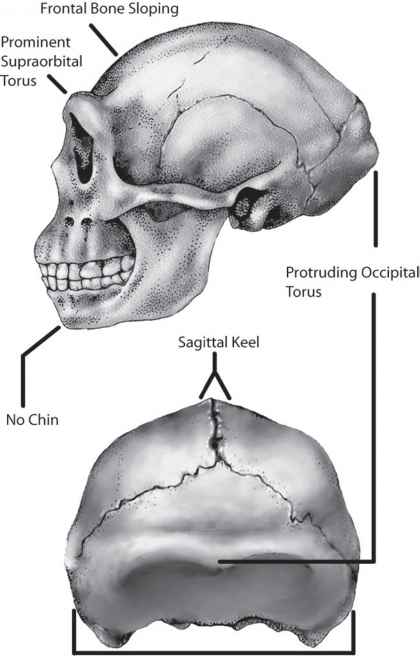
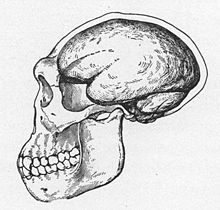
- Indonesia Java near Trinil found by Eugene DuBois 1891.
- Height 5ft 8in
- 70 kg
- Smallest skull
- 800cc
- Not so thick and massive cranial bones
- Cranial suture prominent
- Receding forehead and frontal region is flat
- Heavy and continuous supraorbital ridge
- Broad and rounded occipital region
- Smooth palate
- Larger mandible.
- Saittal keel bigger.
- No chin.
- Projecting canines.
- Diastema present
- Large molars
- Bipedal.
- Peking man. Anderson 1921. Zhoukhudien.
- 5ft
- 50kg
- Large skull
- 1075 cc
- Thick cranial bones.
- Less prominent cranial suture.
- Receding forehead with a bump
- Heavy but reduced supraorbital ridge
- Narrow and elongated occipital region
- Less prominent canines.
- Indication of chinchin
- Less sagittal keel.
- Diastema absent
- Small molars.
- Bipedal
- Culture. Use of fire, Asian tools, group life and some form of language.
Paleolithic |
Paleolithic age ranges from 3.3 mya lomekwi. ago till 12000 ya.
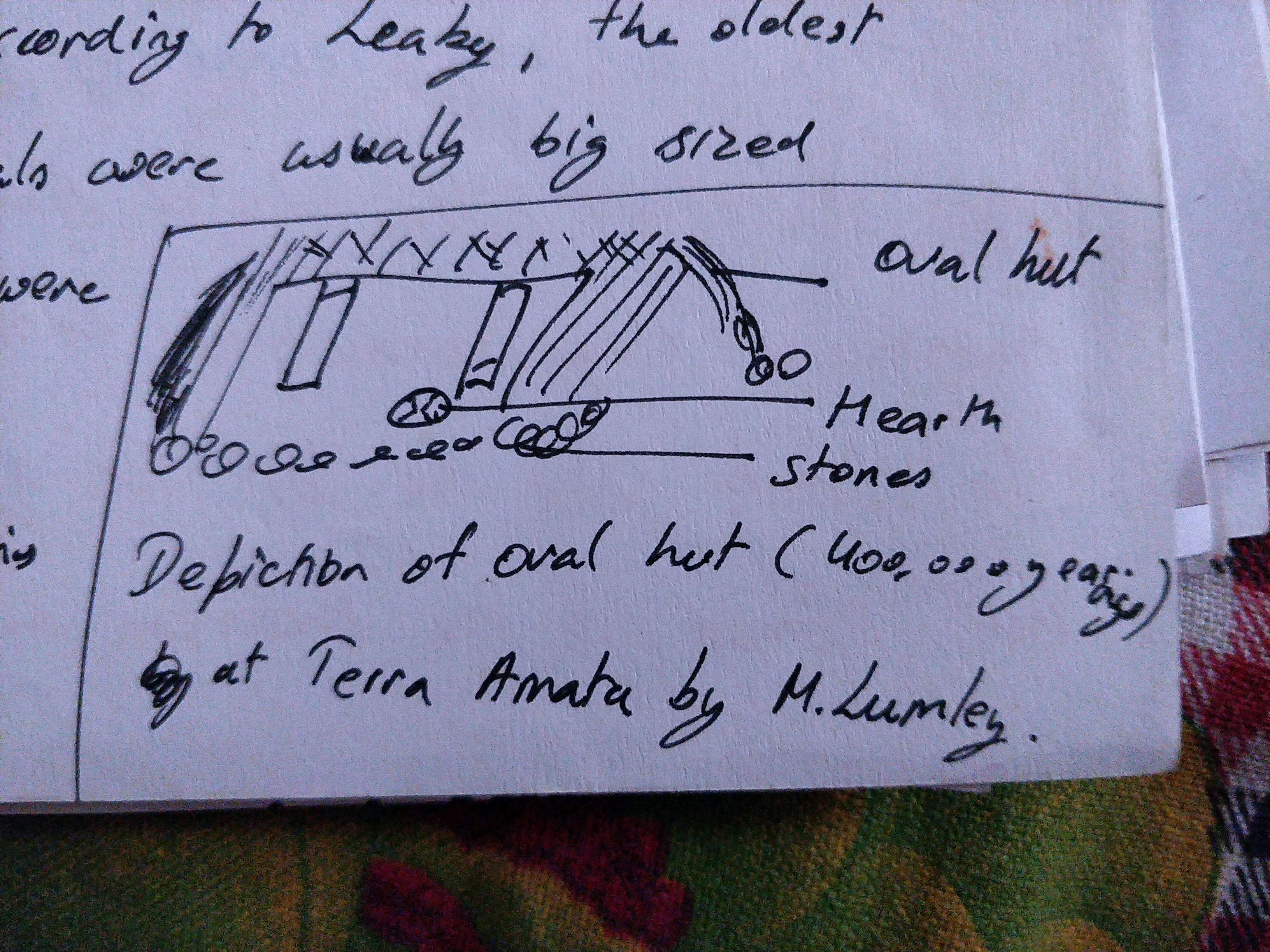
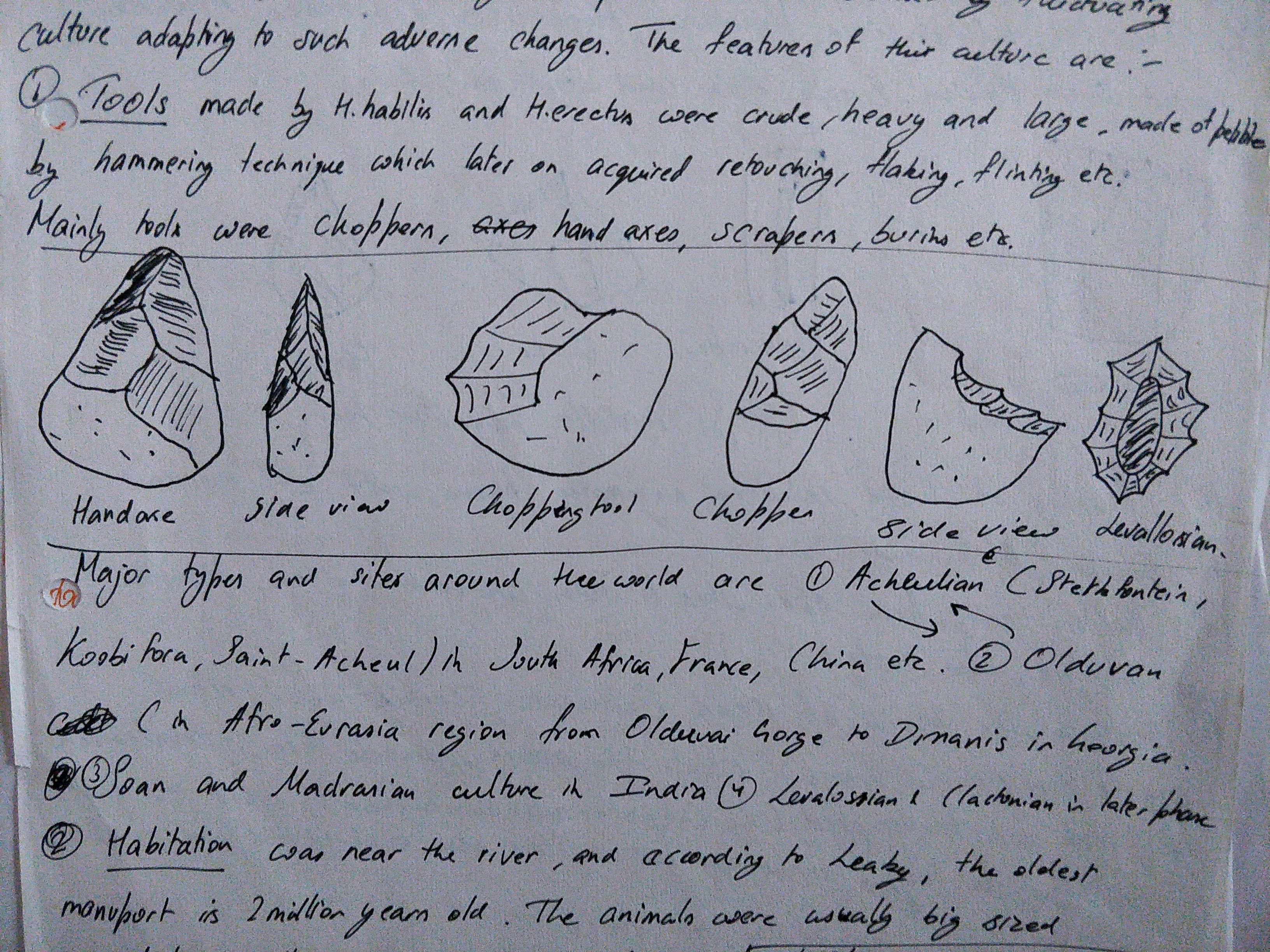
Lower Paleolithic 2.5 million till 300 thousand years ago. Homo erectus. H habilis. Core tools.
Middle. 300kya to 40kya. Upper 40kya to 10kya. H sapiens neanderthal heidelbergensis.
Climate. periodic glaciations.
Tool culture - Oldowan and acheulian tools. Handaxe, cleaver chopping flake tools blades points burin.
Material. Quartz. Quartzite. Bone. Jasper. Chalcedony.
Oldowan by homo habilis and A. garhi. 2.5 to 1.7mya. changing diet from omnivorous to carnivorous scavenging due to dry climate and Savannah.
Europe oldowon tradition is called as abbevillian. Split into clactonian flake tradition and acheulean hand axe tradition. Levallois technique emerged later.
Acheuloan tools 1.5 million till 1 million years ago. uniform and standardized. Oldest from peninj river Tanzania 1.5 mya. Unlike oldowan, acheulian more large tools created in standard designs and shapes. Oldowan tools have sharp edges made by few blows but acheulian tools are created by knocking off flakes.
Acheulian - hand axe common. It is tear drop shaped bifacial flacked tool with thin Sharp tip. Other tools : cleaver, Scrapers and picks. Earlier made from hard stone blow but later from soft hammer of bone or antlers - for better control over tool. Thin sharp and different shapes can be created. Lawrence Keeley show that and handaxe wer good for animal butchery, shaping wood and digging. Found in Africa Europe and West Asia.
Human evolution
H. erectus/ H. ergaster emerged about 1.8 million years ago. Homo erectus move from scavenging to hunting and hunting gathering.
Home erectus found in all areas of old world but tool traditions differ from west to east. Like bifacial hand axe, cleaver and pick not found in eastern and southeast Asia. Yamaei 2000.
600,000 years ago behaviour and physiological changes lead to homo heidelbergensis.
Heidelbergensis homo rhodesiensis and later archaic humans from swanscombe, steinheim, tautavel etc.
Culture
Big game - elephants - hunting. Ambrona spain. FC Howell. Cooperative activity.
Fire. Allowing winter area habitat. First evidence kenya 1.4 mya. Conclusive evidence in 8,00,000 ya Israel gesher benot. Cooking. Heating. Predator away.
Location close to much vegetation, water resources and stalk of herbivorous animals. Campsites like terra Amata, Nice, France. Elephant stags oxen.
Religion and rituals. Red ochre remains found in lower paleolithic sites. Dickson 1990. But unclear if home erectus buried there dead.
Art. Engraved bone found
Regional variation.
Europe clacton-on-sea and Terra Mata, France prominent. Abbevillian then Acheulian culture (400 - 100kya) prominent
East Africa. Oldwan gorge chopper chopping tools.
India Attirampakkam. (2.2 million years ago. Chopper chopping tools ), Sohan Valley, Madrasian culture.
lower paleolithic ended about 300 thousand years ago when Technology, social structure and behaviour got more complex (prepared core technique and changes in hunting gathering ) and emergence of Homo sapiens - oldest Fossil in Morocco jebel irhoud( 2018 science. )
Upper paleolithic |
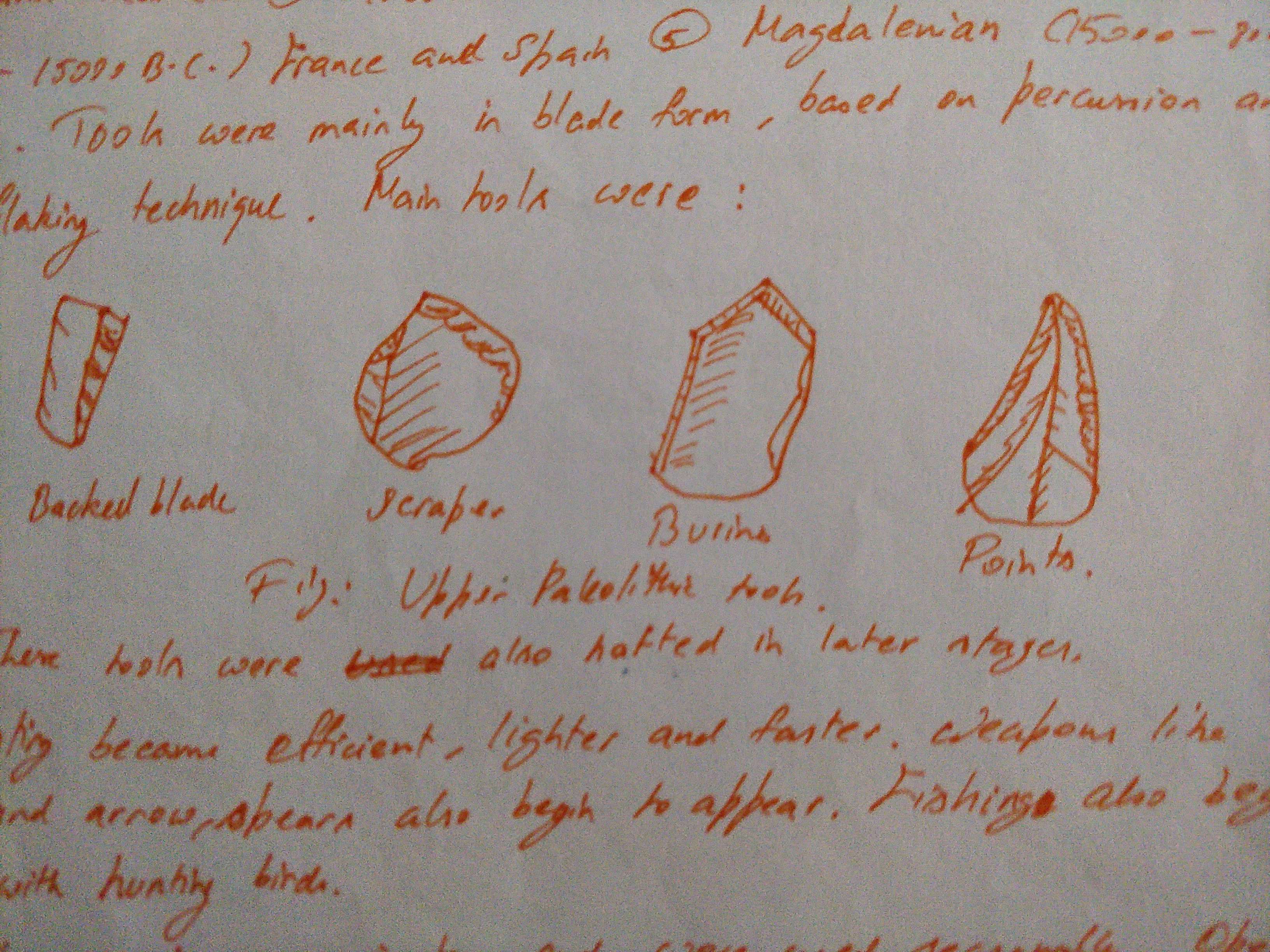
Later stone age in Africa. Between 40,000 and 10000 years ago.
Climate. humans in habitat tropical, subtropical, temperate, desert and after climates. Spread to Australia and America. Middle and late wurm glacial period. Mousterian pluvial period. Last ice age. Pleistocene megafauna ends - Mammoth rhinoceros and giant deers.
Associated with Homo sapiens sapiens and some last populations of neanderthals. Denisovana.
Technology. Blade Technology, elongated flakes by September aur indirect percussion technique. Scrapers burins and backed knives. Microlithic Technology seen during later stone age of Africa and Central and eastern Asia.
Non lithic tools. Bone, and colour and ivory created borers needles and points. Invention of bow and arrow, spheres and tiny replaceable blades.
Cultures
Europe. Perigordian . Western Europe art and bone tools. Blunted Sharp borders of large tools.
Aurignacian. Parallel to above but didn't plant their blades.
Solutrean. paper thin leaf points with pressure flaking.
Magdolian. Bone tools preferred. Azillion tradition developed microlith tools.
Solutrian of Spain and France.
Paleo Indian in the new world. - Clovis culture.
Angara culture - Asia
Sites. CRO magnon and Solutre in France. Altamira in Spain. Zhoukoudian China. Mumba cave Tanzania. Lake mungo Australia. Blackwater draw New Mexico.
India. Bhimbetka - flake technology and bone tools. Chintamani gavy - 90% bone tools Kurnool Andhra Pradesh.
Architecture. Sites with hearths and widespread use of fire. Dense concentration largest population and regular habitation of sides.
Culture. Symbolic art. Representation of animals, humans and abstract geometric patterns. Paintings, carvings, drawing, modelling. pendants and beads made of shell bone tooth and stone. Creative explosion. Ridges and which one symbolism possible. Bhimbetka cave paintings and Lascaux France.
Evidence of trade and relatively sedentary lifestyle.mellars 1994.
Hunting gathering lifestyle with fisheries and band organisation.
Paintings show lifestyle of hunting gathering, dance celebrations. Venus figurines.
The burials are more common and elaborate. Grave goods, jewellery and artefacts.
Middle paleolithic |
300,000 to 40,000. Strauss 1989.
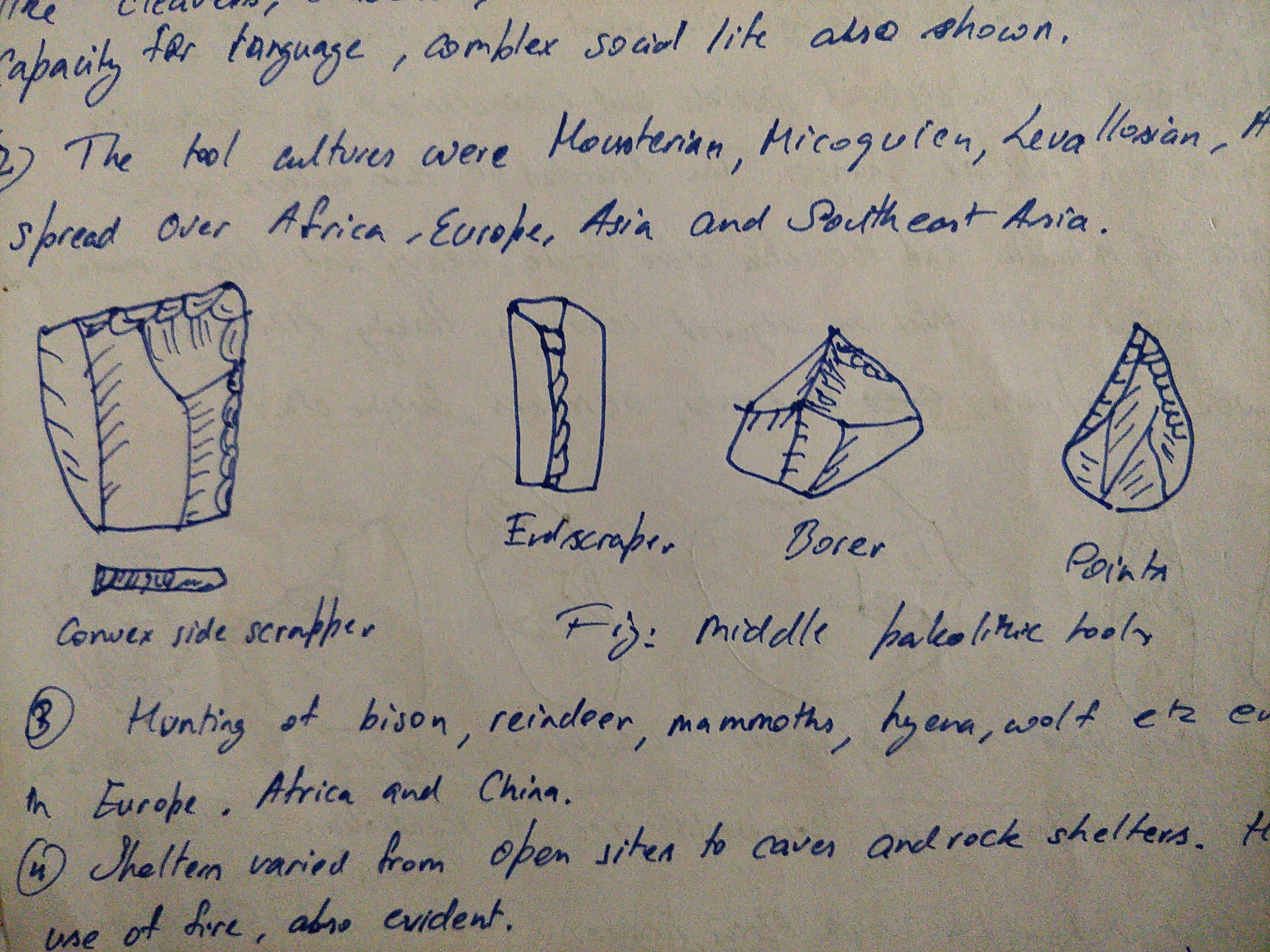
Climate. Quaternary period. Spanning periodic glaciations ( mindel to wurm ). Neandertal to human.
Tools. Acheulian and Levallois technique. Point tool. Side scraper. Borer. Hand axe and cleaver become smaller. Quartzite and softer tools : quartz, agate, Jasper, flint.
Regional variations
India. Bhimbetka. Kurnool. Nevasa best - flake tools with levallois technique.
Euro. Mousterian culture (scrapers and points) levallois technique. Side scrapers and points. Le moustier, France. Small number of hand axes and cleavers and big proportion of flakes. Re Touching of flakes seen. Possible hafting. (Schick and Toth, 1993)
East Africa. Post acheulian. Disappearance of handaxe and cleaver. Emergence of mousteroid culture with levallois technique. But handaxe continued in Uganda with flake technique it is called Sangoon tradition. Klasies river site. Point flakes. Parallel sided flaked blades. Burins. Scrapers.
Social life. Hunting gathering light and efficient tools. Division of labour based on age and sex. Egalitarian society band organisation. First evidence of burial. Language development. More reliance on fire. Open air as well as cave life. Big game hunting like mammoth and elephants. Screening of animals like fox for clothing.
Burial at le moustier and shanidar cave iraq.
Lower Paleolithic |
- Lower Paleolithic 2.5 million till 300 thousand years ago. Schick and Toth 2007.
- Climate. Quaternary period with periodic glaciations.
- Tool culture : Core tool tradition - Oldowan and acheulian tools, tools like handaxe, cleaver, Scrapers - Made by hammer on technique. Lawrence Keeley showed, handaxe were good for animal butchery, shaping wood and digging. Found in Africa Europe and West Asia.
- Africa - Oldowan tools by homo habilis and A. garhi. 2.5 to 1.7mya. changing diet from omnivorous to carnivorous scavenging due to dry climate and Savannah. In Europe - abbevillian which split into clactonian flake tradition and acheulian hand axe tradition.
- Acheulian tools 1.5 million till 1 million years ago. Associated with homo erectus because as they're uniform and standardized - unlike Oldowan tools. Oldest from peninj river Tanzania 1.5 mya.
- Human evolution
- H. erectus/ H. ergaster (1.8 million years ago). moved from scavenging to hunting and hunting gathering.
- Home erectus found in all areas of old world but tool traditions differ from west to east. Like bifacial hand axe, cleaver and pick not found in eastern and southeast Asia. Yamaei 2000.
- H. heidelbergensis (600 kya), H. rhodesiensis etc
- Culture
- Big game - elephants stags oxen- hunting. Ambrona spain. FC Howell. Cooperative activity.
- Use of Fire for cooking. Heating. Predator away. Evidence - 800 kya Israel gesher benot.
- campsites close to much vegetation, water resources and herbivores.
- Religion and rituals. Red ochre remains found in lower paleolithic sites. Dickson 1990. But unclear if home erectus buried there dead.
- Art. Engraved bone found in Oldisleben. R. Bednarik 2006.
- Regional variation
- Europe clacton-on-sea and Terra Mata, France prominent. Abbevillian and Acheulian cultures found.
- East Africa. Oldwan gorge - chopper chopping tools.
- India. Attirampakkam and Soan.
Lower Palaeolithic ended 300,000 years ago when technology and social structure became complex with emergence of Homo sapiens. Oldest fossil Morocco jebel irhoud 2018 Science.
H erectus |
Homo erectus. Upright man.
- 1.9mya to 140 kya. First by Eugene dubois java 1891.Originated from Africa and migrated.
- Geo. sale morocco. Lake turkana Olduwai Swartkrans by leakey in Africa. Java indimesia narmada india sonakia. Dmanisi georgia. Zhoukudien china d black. Box grove uk.
- Homo erectus biological changes
- 770 and 1400 cc. Thick cranial bones. Forward foraman magnum than habilis. Bipedal. No chin. Prominent browridge. Near parabolic dental arcade. Taurodontism present. Linea aspera. 5 to 5.5ft and 50kg. Mastoid process well developed.
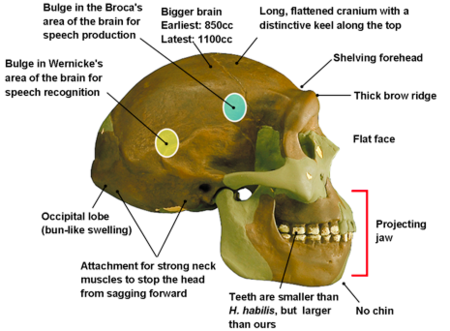
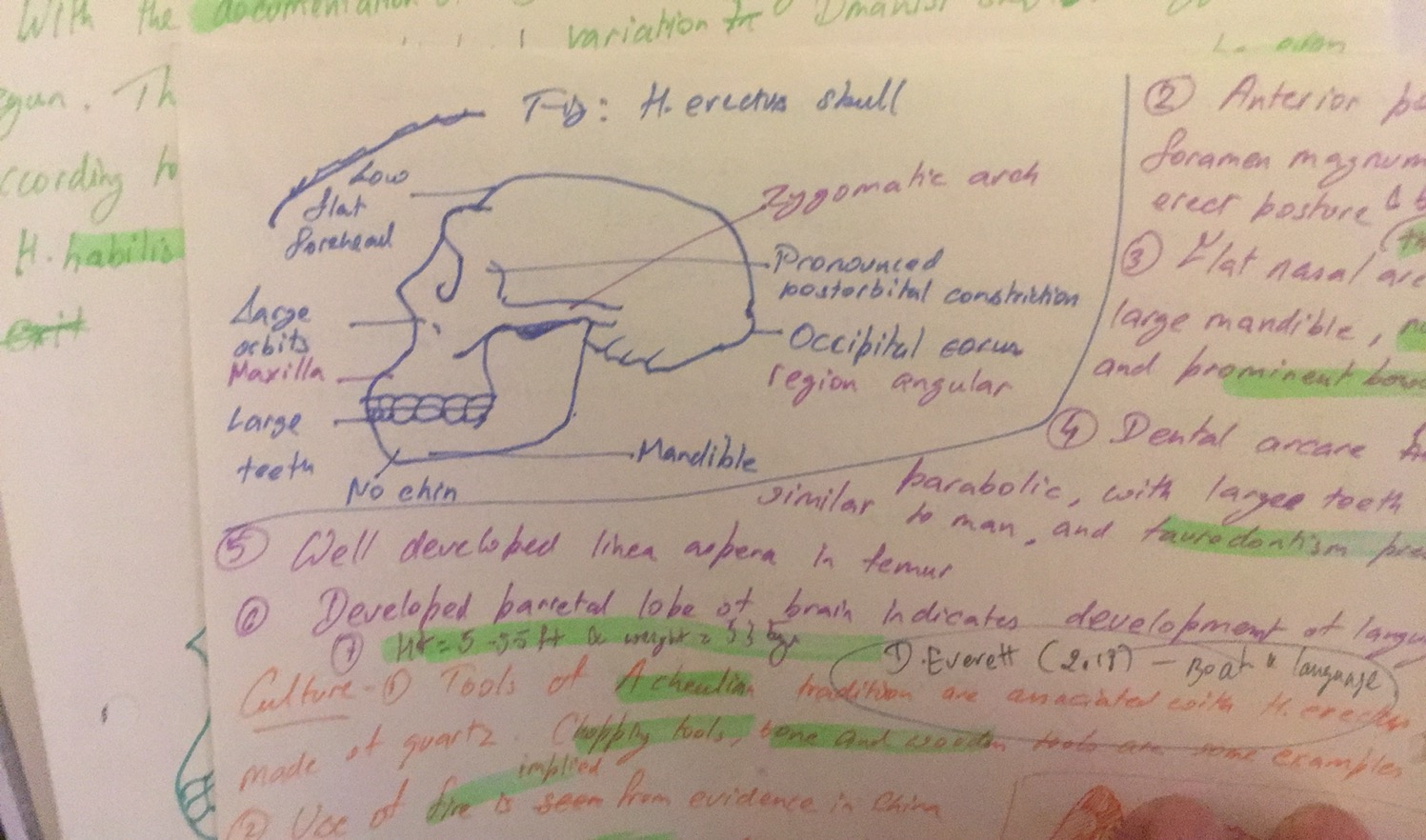
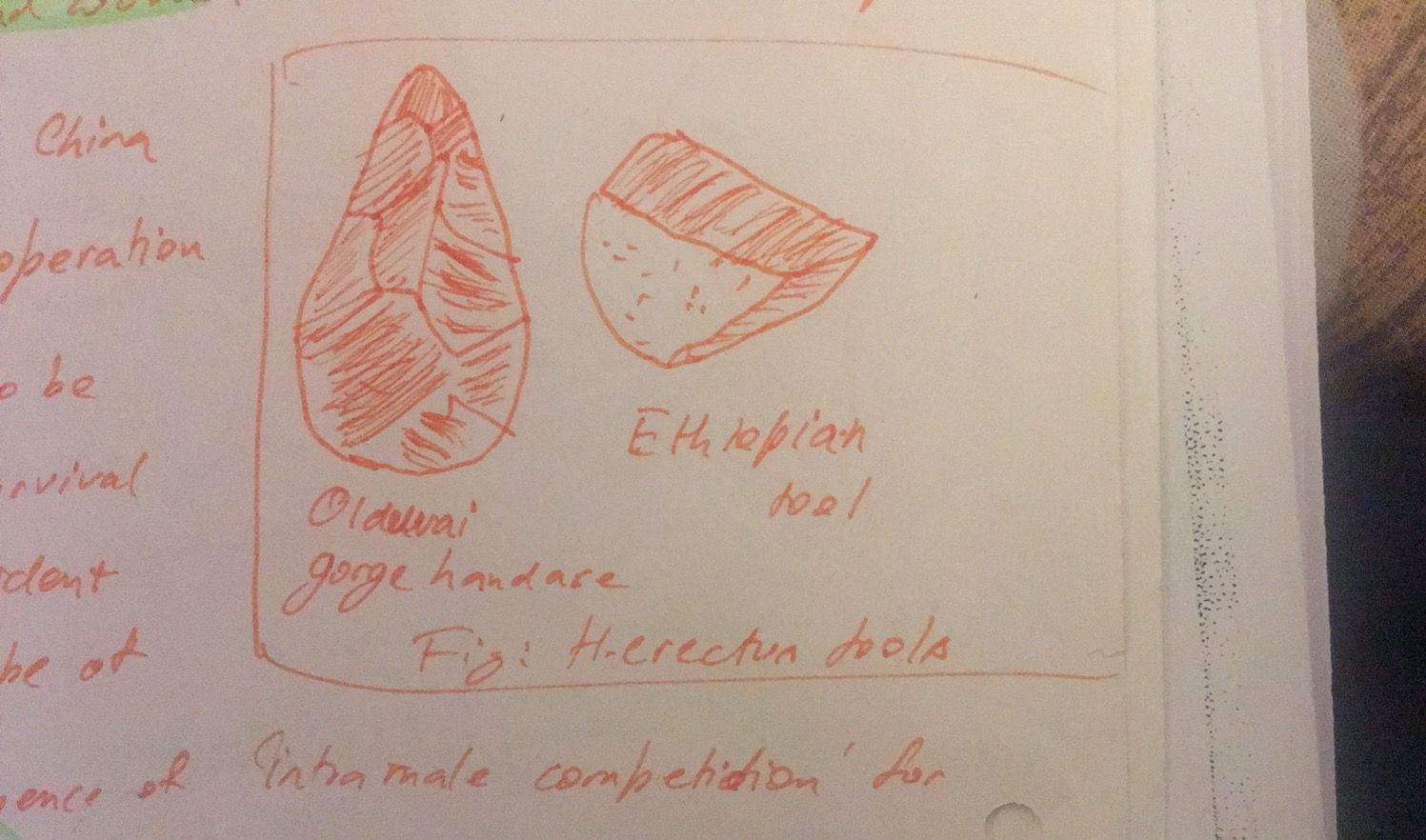
Culture. Acheulian tools.
- D everett believes used boat and language.
- Fire Zhou-Kou-Dien. 1 mya earliest fire example in swastkrans.
- Cannibalism as per hoebel
- Social life.
- Engraving on tools. Maybe art. R bednarick 1994. Didwana crystal quartz and pendant in china possible art work.
Dmanisi 2013 huge variation among skulls. So what if ergaster rudolphensis and habilis are also erectus.
Habilis vs erectus
- * Increase body size from homo habilis. Heavier. Henry Mark Henry and katherine coffing - height increase by 33%. Mostly changes between 2 and 1.7 m y a.
- * Body changes due to climate change and food supply. Adaptation of hunting and meat processing provide better food and nutrition.
- * Pat Shipman. Olduvai gorge butchering and scavenging of animals was observed not hunting.
- * Tools and social organisation allowed better food supply. So show body changed. Advance in tools and Society E due to brain expansion and complex Technology.
- * Acheulian 1.8 mya. more sophisticated and made from wide variety of raw materials into greater range of tool types and functions. Different in variety raw material types and functions from Oldowan tools. Middle awash Valley of Ethiopia shows tools used to kill large animals like hippopotamus.
- * Practice anthropology. Glynn Issac matched the microscopic real pattern of tools by watching the animals and they were the same as acheulian tools used by homo erectus.
- * homo erectus versus habilis point reduction in teeth size. Face and jaw reduction relative to braincase. Increase brain size. Browridge increase. Thick cranial bones. Body increase size. Reduced arms in length. Increase in length. 650 versus 950 CC brain 33% increase. Brain is energy expensive and nutrition resulted from meat which is protein rich.
- * Use of fire point 1 million years ago. F Berna from South Africa -Wonderwerk.
- * Zhoukoudian fire evidence. Pyre allowed expansion of humans in cold regions.cooking made easy to chew and powerful Joe and large teeth were not necessary. Therefore middle pleistocene hominin head smaller jaw and teeth. food sharing in social organisation also allowed better nutrition for all.
- Homo erectus pattern of evolution.
- * Skull. Long low and wide at base point thick bone and large brow ridges.
- * More robust with largest and thickest cranial bones. Sagittal keel present in in African homo erectus.
Human evolution |
Human evolution
- After separation from chimpanzee 8 to 10 million years ago. Wilson 1971 genetic clock.
- Six major attributes. Larsen 2016.
- Bipedalism 6. Started in Ethiopia Woodlands not grasslands. Changes in spine pelvis childbirth foot femur Linea aspera. Helix not possible. Angling of knees. Efficient walking.
- Non honing chewing. lack of projecting canines and diastema. 5.5
- Complex material culture and tool used. 3.3 Kenya lomekwi tools.
- Speech. 2.5. Hyoid bone. Brain areas develop
- Group Hunting 1 million years ago. Energy for large brain.
- 11000 domestication new lithic
Models of origin
- Out of Africa. Christopher Stringer. spread out from Africa after 50 thousand years ago. Replaced other populations.
- Ken 1987. MtDNA analysis. Out of Africa theory.
- Multi regional theory. Milford Wolpoff. Award from archaic populations in Africa Europe Asia. Always gene flow across borders.
- Kramer. 1991. Study jaw from java. Argued for multi regional origin
- Assimilation
- Fred Smith. Erik Trinkaus. first evolved in Africa then spread to Europe and Asia where they had gene flow with neanderthals.
- Recent Fossil in Greece Homo sapiens found. 210kya. Apidima cave.
50,000 years ago species of humans were Homo sapiens neanderthal denisovans florensis luzonensis.
Luzonensis are Pygmy humans with teeth like humans but curved fingers and toe like australopithecus. Philippines.
Erectus asia africa europe |
Erectus asia africa europe
Homo erectus Asia. First 1890 Eugene.
* earliest evidence is 5 skulls bones and tools in Georgia by Georgian paleontologist David L - Dmanisi. 650 cc brain size and large face. 1.8 mya. Asia. Compared to African homo erectus they had faces and jaw smaller and Browridge less developed. But very e similarities in other areas like mandible of ilret skull. Leg bones longer than arms.
* Kocabas village Turkey five hundred thousand years ago Fossil found. Massive brow ridge and sagittal keel. Signs of tuberculosis.
* Sanigiran Indonesia. 1000cc brain capacity with thick cranial bones and large brow ridges with slight sagittal keel similar to homo actors of Africa Asia and Europe. Large brain and small teeth.
* therefore rapid spread from Africa to outside due to better intelligence reliable on on the material and social behaviour. Diverse diet.
* Gongwangling Fossil Shaanxi province. 1.2 million years ago. Well developed brow ridges and thick cranial bones with 800 CC capacity. Animal bones with butchery marks and stone artefact are found by RX Zhu.
* Zhoukoudian. 1200cc. 1920 discovery 1940 excavation. 87 80000 years ago. 40 to 50 individuals. Stone tools and food remains. Franz Weidenreich.
Homo erectus Africa. 1.8 and three hundred thousand.
* Some australopithecines also around.
* Nariokotome, Westside Lake turkana 80% Juvenile skeleton point 1.6 m y a. Turkana boy 1984
* Short arms and long legs. Committed to terrestrial life with fully modern stride. Absence of sagittal crest. Smaller molars and thinner enamel reflecting soft diet. Some had robust bones while others had Gracile.
* Ilret footprints. Koobi fora footprints in Kenya. Just like modern human walking. Double arch, adducted big toe. long distance walking running and hunting very likely.
* Other fossils from Olduvai Tanzania.
* 1.2 mya. Daka place. Bodo 0.6 mya. very robust with thick cranial bones and large Browridge.
* Tim white sound linear marks on the left cheek with microscopic analysis it was caused by stone tools which means some ritual cannibalism. Ritual defleshing. OH 9 Fossil.
- homo erectus Europe. 1.2 till 400 kya.
- * Earliest from Western Europe, Sierra de Atapuerca Spain. Cave site of Sima del elefante 1.2mya. Also Gran Dolina 900,000
- * Partial mandible and some teeth. Animal bones with cut marks from butchering. Many stone tools. Animal bones broken which means food was processed before consumption.
- * Mauer jaw mandible and mostly teeth from heidelberg Germany five hundred thousand years ago.
- * Boxgrove UK.
Homeo actor special features |
Home erectus special features
- Cranial bones very thick. Receding frontal bone. Strongly developed supraorbital torus. Small mastoid process. Broad nasal bone. Pronounced prognathism. Flat forehead. Massive body of mandible. Large upper incisor.
- Several characters are similar. cranial capacity is within homosapiens range. Relative size of face is reduced. foramen Magnum similar to Homo sapiens. Dental arcade is parabolic. Post cranial anatomy is similar to Homo sapiens.
- Evolve from homo habilis within a short span of time which is called punctuated equilibrium. 2 to 1.5 mya.
Homo habilis |
Habilis. Habitual toolmaker.
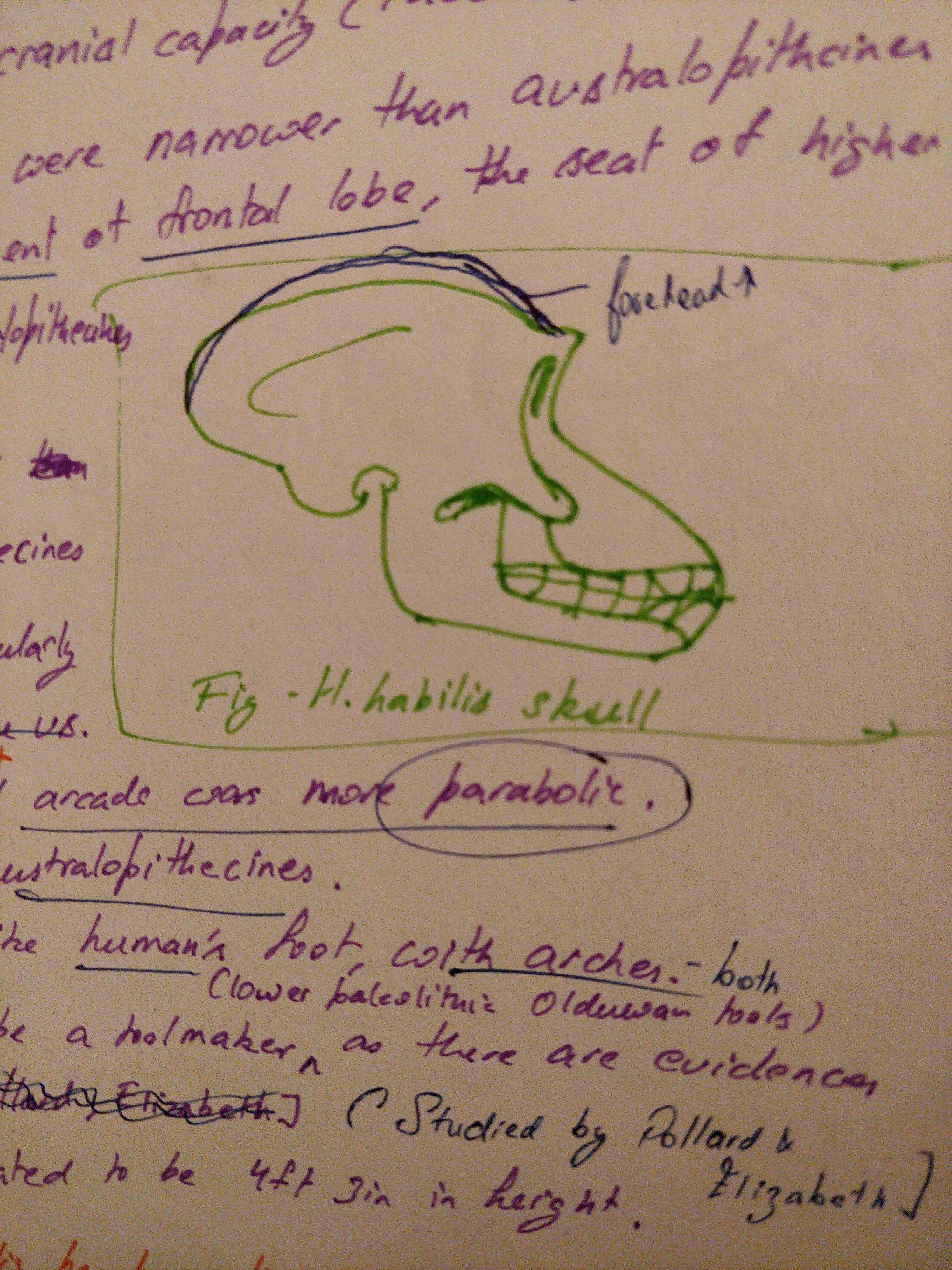
* 2.5 to 1 mya.
* First homo.
* Found in East Africa and South Africa. Lake turkana. Sterkfontein.
OH 24 or Twiggy in Tanzania 1968 1.8 million years ago. Less protruding face and larger brain.
* OH 7 Tanzania 1960 1.75 million years ago small dental size, increase brain size. Johnny's child. Olduwai gorge.
* Louis leakey Philip Tobias and John Napier studied and described as homo habilis from Tanzania Kenya Ethiopia Malawi and South Africa.
* homo habilis found on eastern side of lake turkana is called homo Rudolphensis. It is bigger than homo habilis.
* Smaller chewing complex and larger brain. Rounded skull. It Tim White studied differences between homo habilis and australopithecine and suggested that australopithecine garhi was its ancestor because says Jaw and teeth are mostly similar. Transition took between 3 and 2.5 million years ago.
* Donald Johnson 1980 discovered skeleton apart from skull. Bipedal short legs in comparison to arms.
* Intelligence and use of tools. Large brain small chewing muscles and smaller teeth then australopithecines. Dependence on tool used indication.
Premolars with two ridges.
Less massive mandible.
* stone tools are more common in homo habilis sites than australopithecus sites. Cognitive advancement proved by increased tool making and tool used. It tools were fundamental to their survival. Diverse diet.
* warming around 2.5 million years ago increased habitat diversity and increased food resources for homo habilis. Therefore it had died versatility. 2.5mya capacity for speech.
* 650 cc. Long arms. Less protruding face. Parabolic dental arch. Small teeth. 4.3 ft.
Narmada man |
Sankhyan 2016
Calvarium. Hathnora district 1982. Sonakia. 300 kya archaic hominin.
Clavicle. 1997. Sankhyan. 150 kya. Middle paleolithic flake tools and small body archaic type. H. narmadensis. 2013 sankhyan.
Femur and humerus fragments Netankheri. 2010. Sankhyan.
300 to 75 kya
Possibly three types of hominins. First one is H. heidelbergensis and second is Homo narmadensis.
Small bodied hominins.
25 to 40 kya Andaman Pygmy separated from mainland Indian groups.
Femur and calvarium. Date 300kya. Archaic hominin. Acheulean mode 2.
Humerus 75kya.
Calvarium is female Kennedy 1991. 22 characters of home erectus are present like sagittal keel, separation of Inion from endinion. Well developed mastoid fissure, uninterrupted supraorbital Torus. Strongly developed occipital torus.
But features like small mastoid process, narrow post orbital constriction, prominent bilateral Torus angularis are uniquely present in Asian homo erectus. Kennedy 1991 classify the skull cap as archaic Homo sapiens Because cranial vault is relatively doll. Cranial capacity is between 1100 and 1400 cc. Maximum cranial length falls superior to inion.
Sankhyan think it is closer to home heidelberg.
Clavicle
1997. Shape of robust Homo sapiens. But the cross section at mid diaphysis is less round and has less axial twist than modern humans. compare this Fossil with the help of archaeological Anthropology survey of India and Andaman islanders tu arrived at conclusion.
Humerus
Gorilla vs man |
Gorilla vs man
- Hominidae family
- Concentrated in Central Africa
- Two species of gorilla one species of man
- Sexual dimorphism present in both
- Hair all over the body
- 500 cc vs 1450 cc
- Facial skeleton more developed than cranial skeleton in Gorilla
- Sagittal crest present
- Flat and receding occipital region
- Large mandible
- Prominent supraorbital ridge
- Dental shaped U
- Diastema present
- Spinal single curve
- Knuckle walking
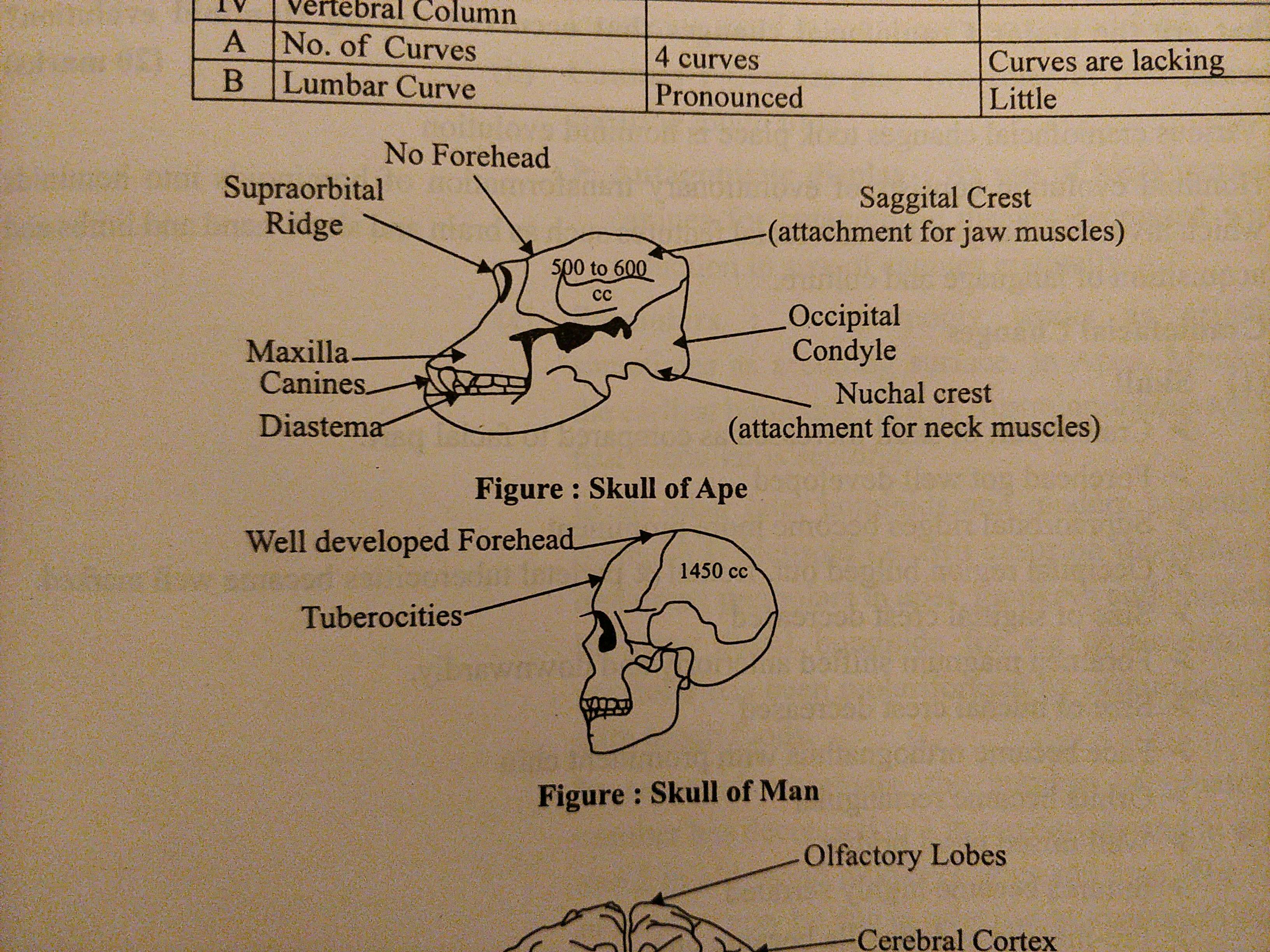
- Capacity for understanding symbolic language Koko the Gorilla and short term memory may be better than humans.
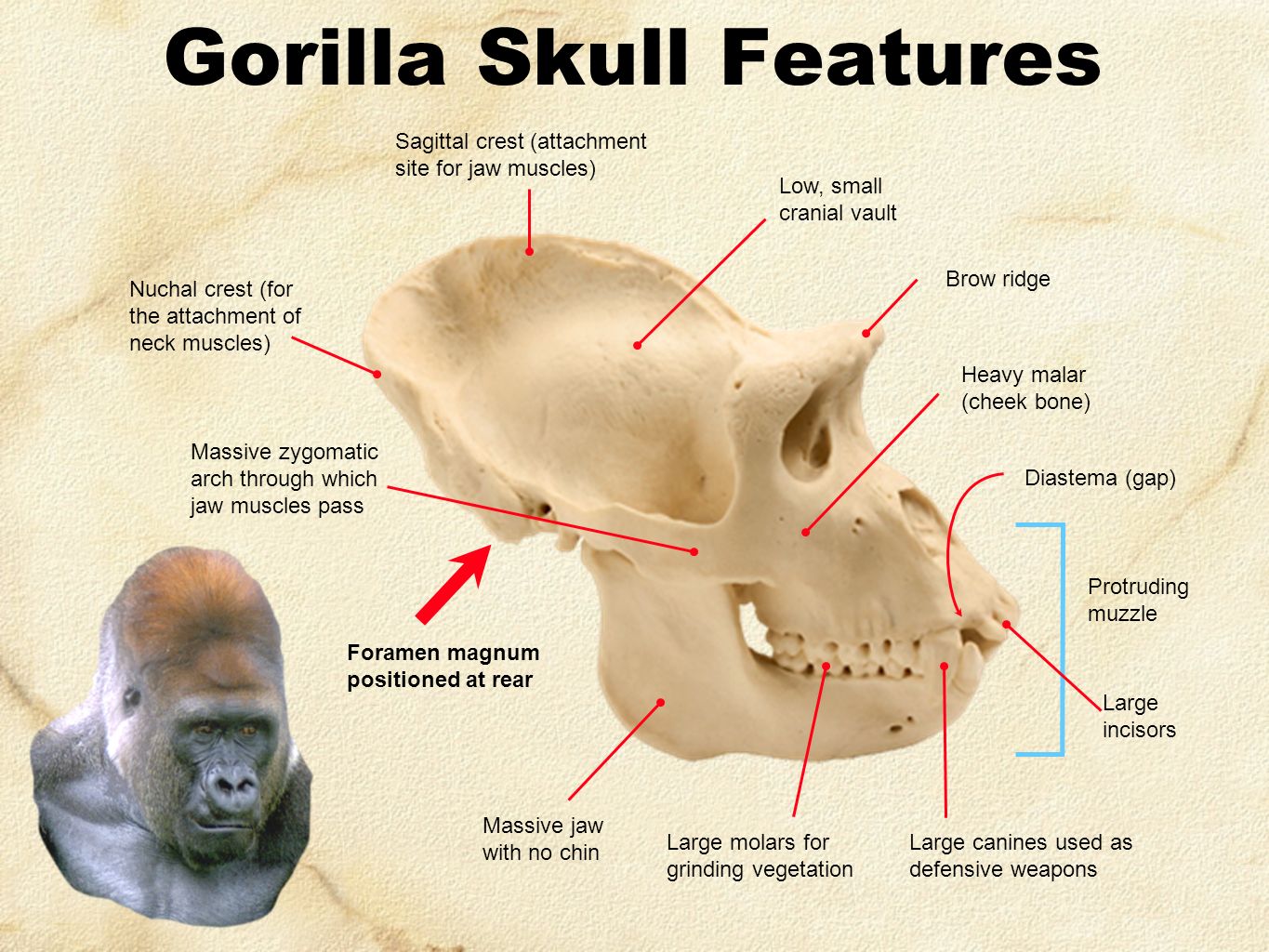
Sivapithecus |
Miocene. Golden age of hominoids
Climate
Continental shifts. Collision between South Asian plate and Southern Asia was producing Himalayan plateau. Miocene considerable warmer than proceeding oligocene.
19 million years ago Arabian plate connected with North East Africa which allowed Migration of animals.
First Fossil in 19 century but complete in 1934. G Edward Lewis. He called it ramapithecus.
Another find was made in Nepal on the bank of Tinau River, Butwal; a western part of the country in 1932. This find was named "Ramapithecus".
Sivapithecus genus. Ape of Shiwaliks.
Time
Miocene ape. Fossils range from 12 and 7 million years ago.
Geographic distribution
Lufang valley China. Turkey 5 skulls. Potwar plateau and Shiwaliks India - teeth and jaw. Nepal Pakistan. lived in mixed Woodland grassland environment.
Classification
Primate, hominidae, ponginae. Previously believed as human ancestor but now clear that Much closer to modern orangutan.
Species
S. parvada S. punjabicus S. sivalensis
Physical features
- Flat and thickly enameled molars. Smaller canines. Slightly Parabolic dental Arcade. Diastema.
- Modern chimpanzees and Gorilla have thin enamel teeth. Large upper central incisors. Tiny lateral incisors. Large canines.
- Robust jaw bones. concave face, narrow nasal bones, oval eye Orbit from top to bottom.
- Projecting premaxilla
- Diet. Course grasses and seeds point some Scholars argue that fruits were the focus.
- Possibly related to gigantopithecus which had similar teeth to sivapithecus.
- 4.9 ft height. Chimpanzee like feet. Flexible wrists. Large zygomatic bones. Arboreal quadruped. Significant sexual dimorphism.
Debates
- Before 1970 is it was believed that sivapithecus was an ancestor of Hominidae. But in 1979 David Pilbeam and Ibrahim Shah discovered partial sivapithecus Skull. Middle skull in the image.
- Ramapithecus is very similar to sivapithecus but just smaller in size. Possibly a female version of Sivapithecus.
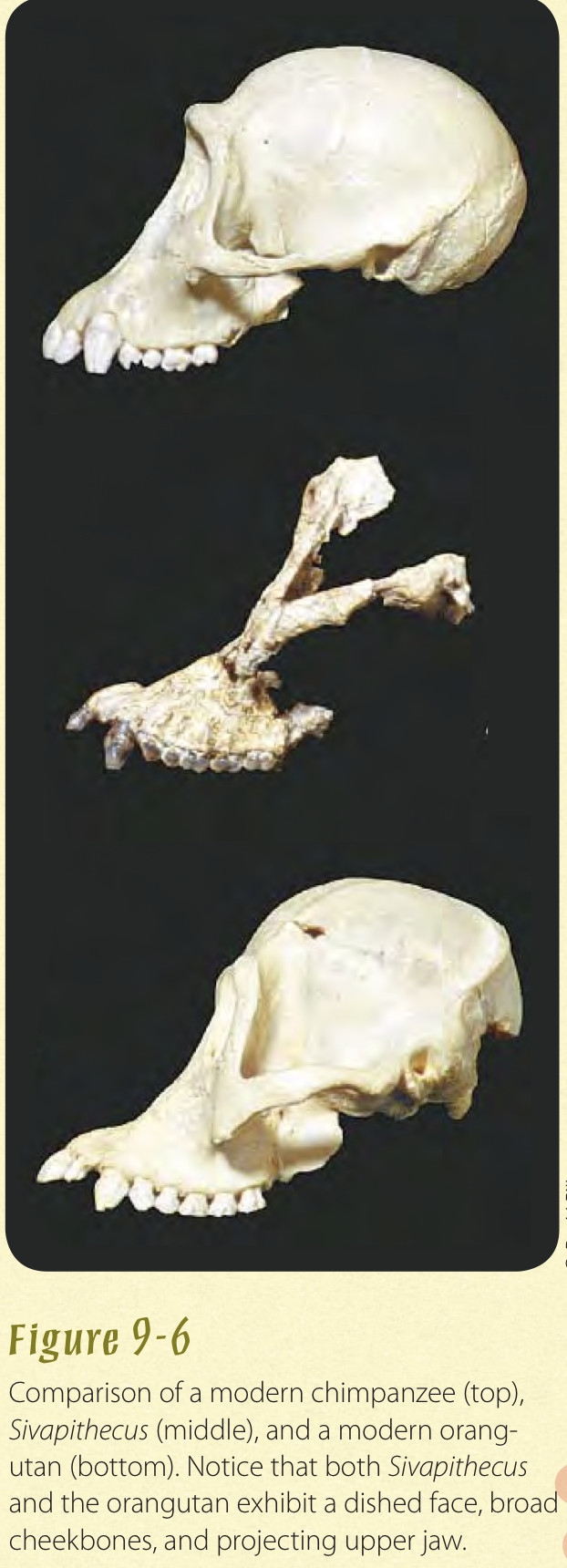
Ramapithecus. Miocene.
Ramapithecus, fossil primate dating from the Middle and Late Miocene epochs (about 16.6 million to 5.3 million years ago). For a time in the 1960s and ’70s, Ramapithecus was thought to be a distinct genus that was the first direct ancestor of modern humans (Homo sapiens) before it became regarded as that of the orangutan ancestor Sivapithecus.
The first Ramapithecus fossils (fragments of an upper jaw and some teeth) were discovered in 1932 in fossil deposits in the Siwālik hills of northern India. No significance was attached to those fossils until 1960, when American anthropologist Elwyn Simons of Yale University began studying them and fit the jaw fragments together. On the basis of his observations of the shape of the jaw and of the morphology of the teeth—which he thought were transitional between those of apes and humans—Simons advanced the theory that Ramapithecus represented the first step in the evolutionary divergence of humans from the common hominoid stock that produced modern apes and humans.
- Simons’s theory supported by David Pilbeam and soon gained wide acceptance among anthropologists.
- The age of the fossils (about 14 million years) fit well with the then-prevailing notion that the ape-human split had occurred at least 15 million years ago.
- The first challenge to the theory came in the late 1960s from American biochemist Allan Wilson and American anthropologist Vincent Sarich, who, at the University of California, Berkeley, had been comparing the molecular chemistry of albumins (blood proteins) among various animal species.
- They concluded that the ape-human divergence must have occurred much later than Ramapithecus. (It is now thought that the final split took place some 6 million to 8 million years ago.)
- Wilson and Sarich’s argument was initially dismissed by anthropologists, but biochemical and fossil evidence mounted in favour of it.
- 1976, Pilbeam discovered a complete Ramapithecus jaw, not far from the initial fossil find, that had a distinctive V shape and thus differed markedly from the parabolic shape of the jaws of members of the human lineage.
- He soon repudiated his belief in Ramapithecus as a human ancestor, and the theory was largely abandoned by the early 1980s.
- Ramapithecus fossils subsequently were found to resemble those of the fossil primate genus Sivapithecus, which is now regarded as ancestral to the orangutan; the belief also grew that Ramapithecus probably should be included in the Sivapithecus genus.
Characteristics of Australopithecus africanus: |
Characteristics of Australopithecus africanus:
Skull: Taken as a whole, the skull is a combination of small brain case and large jaws. The brain case lacks high vertical forehead of Homo sapiens and the high roundedness of the skull vault. This gives a simian appearance. But in bone feature it contrasts with pongidae and matches with hominidae.
- The supraorbital height index shows that the relative high exceeds range of variation in anthropoid ape and actually comes within the range of hominid skull.
- The occipital torus and the inion occupy a low level as in hominid skulls. In adult apes this occipital torus forms a crest high up the occipital aspects of the skull, thus extending considerably the nuchal area for attachment of neck muscles. In Australopithecus the nuchal area is restricted as in homo.
- In Australopithecus the occipital condyles are forward in position relative to the total length of the skull and the auditory aperture. The occipital condyles of pongidae are behind the midpoint of the cranial length and also behind the auditory apertures.
- In all the Australopithecus skulls in which mastoid region are sufficiently well preserved, there is a well marked pyramidal process typical of hominid form.
- The brow ridges are poorly developed compared to that of the apes.
- The facial skeleton is however, large in relation to the brain case.
- The cranial bones of Australopithecus robustus are thicker than the Australopithecus africanus and the sagittal crest is developed. The zygomatic arches are expanded and flared.
- The jaws are also relatively large but no simian shelf.
Cranial capacity:
In cranial capacity, the range of variation is quite considerable. The skull of Australopithecus afarensis and Australopithecus africanus ranges from 400 to 500 cc and Australopithecus robustus ranges from 410 to 530 cc.
Thus the general endocranial size of Australopithecus does not differ markedly from those of gorilla and chimpanzee. However in relation to the body size Australopithecus shows larger brain capacity proportion than the apes.
Dentitions:
Australopithecus dentition is essentially of hominid type. In all the adult specimens the dental arcades is evenly curved as in Homo sapiens with no diastimic intervals. The canine is reduced in size and spatulate in forms. Canines and incisors are almost in the same level.
The anterior upper premolars have two roots, the anterior lower premolars are non-sectorial and have one root (sectorial and two roots in apes). There is good evidence for the study of the immature specimens that the order of eruption of permanent teeth agrees with the Hominidae. In Homo sapiens the canine erupts before the second molar. This is reverse in the apes.
Pelvis:
The total morphological pattern of the pelvis of Australopithecus is hominid.
- The anterior inferior iliac spine is strongly developed.
- The ilium is much relatively broader than in the apes. The broad ilium lengthens the attachment of the gluteus muscles that makes important in maintaining balance of the trunk on the legs. The gluteus maximus becomes a fourfold extension muscle which is needed for erect bipedal locomotion. Whereas in monkeys and apes the gluteus maximus is an abductor muscle.
- The posterior extremity of the iliac crest is extended backward and downward in the sacral area.
- The angle of the sciatic notch (depression) is more acute in the pelvis of man and Australopithecus than that of the great apes. This is resulted in part due to development of prominent ischial spine.
- Ischial tuberosity is relatively high in man and Australopithecus and closer to acetabulum than that of the apes.
- Sacrum is shifted upward and closer to the acetabulum forming more or less a basin or funnel shaped pelvis which indicates the character of erect posture.
In all these characters the pelvic bone of Australopithecus contrasts with the apes and shows pattern for erect bipedalism. However the pelvis of Australopithecus is not fully developed like that of the modern man. Ischail tuberosity is not as quite closely approximated to the acetabulum as it is in Homo sapiens. The anterior superior spine extends further forward.
Limb bones:
In addition to the pelvis, the Australopithecus finds include many fossilized bones of leg, hand and feet. One group from Olduvai Gorge includes twelve of the major bones of a single foot and so perfectly preserved that the details of the foot are readily reconstructable.
The foot of Australopithecus is much smaller than a human foot. But the metatarsals are hominid and the big toe points forward and not splayed out. The carpe bones and phalanges found in Olduvai Gorge also show hominid characters.
Two specimens of the lower part of femur found at Stenfontein have been described. They show a combination of features such as the obliquity of the shaft, the alignment of the condyles, the forward prolongation of the intercondyler notches which confirm to the hominid femur.
Upper extremity of one specimen, however shows certain Pongidae features, such as relatively small size of the articular head. A tibia and fibula found in Olduvai have relatively straight shafts conforming to hominid character.
Difference between Australopithecus africanus and Australopithecus robustus:
Character | Australopithecus africanus | Australopithecus robustus |
Height | 1.1 - 1.4 m. | 1.2 - 1.4 m. |
Weight | 30 - 60 kg. | 40 - 80 m. |
Physique | Light build, probably relatively long arms, more human features; Probably less sexual dimorphism. | Very heavy build, relatively Long arms; marked sexual dimorphism. |
Brain size | 400 - 500 cc | 410 - 530 cc |
Skull form | Low, flat forehead, brow ridges less prominent. | Prominent crest on top and back of skull, long broad flattish face strong facial buttressing. |
Jaw teeth | Small incisor like canine, no gap between upper incisors and canines, larger molars. | Very thick jaws, small incisors and canine, incisors and canine, very large molars. |
Phylogenetic Position:
Currently there are three main phylogenetic trees each with its own cadre of proponents. The problem of whether Australopithecus africanus represent early grade in homo lineage or a small brain hominid arising as a separate product of Ramapithecus radiation is yet to resolve.
At the same time we also do not know how the two dimorphic forms i.e. gracile and robust Australopithecines are to be classed phylogenetically. Whether they reflect polytypic nature of single taxon or systematic enough to conceive as two taxa is still a question.
There is no generally accepted phylogenetic tree for human evolution. There are several proposal branching perhaps the major distinction between them is whether homo is perceived as late arrival or as early arrival.
In some phylogenetic, robust is consider to be on the same evolutionary line with Australopithecines and some consider robustus to be separate from the earlier gracile species in which Paranthropus robustus/promethecus is equivalent to Australopithecus robustus and Homo africanus equivalent to Australopithecus africanus.
This Pliocene and Pleistocene fossils have shown both hominid and ape like features. However the hominid features are overwhelming. The presence of ape like features can be accounted for by way of common inheritance from a hominoid or Pongidae ancestor.
The hominid characters however can be accounted for by way of independent acquisition demonstrating and highlighting the fact that these fossils were on a direct line of human evolution and not Pongidae line.
There are many schools of thought prevailing with reference to the course of evolution these australopithecine have taken. The most important of these are discussed below.
According to Donald C Johnson and Timothy white the east African fossils Australopithecus afarensis split into two branches and australopithecine line represented by A. africanus P. robustus, P. boisei and a hominid line represented by homo habilis, homo erectus and homo sapiens.
This split was supposed to have happened 3 million years ago. The australopithecine line progressively became robust. This pattern generally called two branched theory had its variants also. For some it is A. africanus which is the common link between the australopithecine line and homoline. For still others these two branch represent parallel evolution.
According to this two branch theory A. afarensis gave rise to A. africanus 3 million years ago of the same height living up to two million years ago.
Next arrived A. robustus which showed marked increased in the robustness of the body face , jaws and teeth and it had lined up to 2.3 to 1.8 million years ago. Finally the last and the most robust form A. boisei lived in east Africa from roughly 1.8 to 1 million years ago.
The second branch of this model the homo line also shows a shortening of the face but there is marked decrease in the size of both cheek teeth and the front teeth. There is a massive increase in the size of brain also. This line begins with ta transition form A. afarensis to H. habilis the first hominid who made and used tools and lived in Africa from 2-1.5 million years ago. They had human like teeth and larger brain than australopithecine (750 cc). however we can conclude that hominid evolution may not have been so simple, isolated and clear cut in tis operations.
Instead there is a possibility that three or more hominid lineages may have been evolving and interacting with each other.
This two branch theory was widely accepted till the discovery of the new type of hominid skull - Australopithecus aethiopithecus in northern Kenya inn 1985 by Alan Walker. This skull is considered to be the most robust form ever discovered. It had massive teeth and ape like brain.
The dating of the this specimen indicates that the family of a. boisei didn't evolve in the last leg of the australopithecine evolution as indicated by earlier theory but it originated directly from a. afarensis. Thus the revised theory holds a three line evolutionary sequence. One to boisei line second to Homo and third to africanus, robustus line having A. afarensis as the common ancestor.
The discovery of the youngest australopithecine - A. ramidus has added a new dimension to the three branch theory. It holds that A. afarensis is the common ancestor of Homo, P. boisei and P. robustus but it itself evolved from A. ramidus. With overspecialization of diet, competition for food with H. habilis and the latter's predation along with H.erectus led to the extinction of australopithecine group.
Why are the genera Australopithecus divided into two species?
At first, several discoverers of the various Australopithecus fossils named four to five different genera, but now the consensus of scientific opinion recognizes one genus Australopithecus and two species, one gracile form represented by Australopithecus africanus and other robust form represented by Australopithecus robustus, originally called Paranthropus. This division is made on the basis of their morphological feature.
The gracile form are slenderly built and smaller; gracile form have probably relatively long arm, probably less sexual dimorphism, high forehead, shorter face, brow ridges less prominent. The incisors are also small with no gap between upper incisor and canines and have big molars; cranial capacity ranges from 410-530 cc.
The robust form are large and roughly built. They have relatively long arm with moderate sexual dimorphisms, crest on top of skull, flattish face. The robustus have thick jaws, small incisors and canine, very large molars; the premolar is also large like molars. The cranial capacity ranges from 410- 530 cc.
What is the position of Australopithecus in the line of human evolution?
Different scholars have given different opinion about the position of Australopithecus in the line of human evolution. According to Johanson and White Australopithecus afarensis is regarded as the common ancestor of Australopithecine and Homo.
Australopithecus afarensis rise to Australopithecus africanus and to Homo in one hand and directly to Australopithecus robustus in the other hand. Here Australopithecus africanus act as a transition form from Australopithecine to Homo.
According to L.S.B. Leakey, the common ancestor of both homo lineage and Australopithecine divided quite early. He considers Australopithecus afarensis as not the common ancestor. The homo lineage starts separately after 3 million years and Australopithecus a little bit early but also only 3 million years.
What is T. Robinson Dietary hypothesis?
Going by the dental fossil evidence found in East and South Africa, there are two adaptive groups which can be extended to families. These two adaptive groups are gracile and robust. They are quite distinct in morphological, ecological relationship and behavior.
T. Robinson sees a dichotonomy in cranio-dental form separating these two Australopithecines groups. Robust group has the large post canine teeth crowns, thick enamel, larger occlusal surface, well developed root and relatively flat occlusal surface (greater enamel has been damage).
Crowning and size reduction of the front teeth points to a primary dietary function of crushing and grinding. The massiveness of the entire mastigatory apparatus including the musculature and the wear of the teeth indicate use of a diet of rough material which needed much chewing.
Hence robust was herbivorous or vegetarian. Gracile form shows none of these features rather their post canine teeth are smaller and anterior teeth larger. The needs for these in meat eating would be substantial until tool making had reached a fairly advanced level.
Homo evolution |
Homo
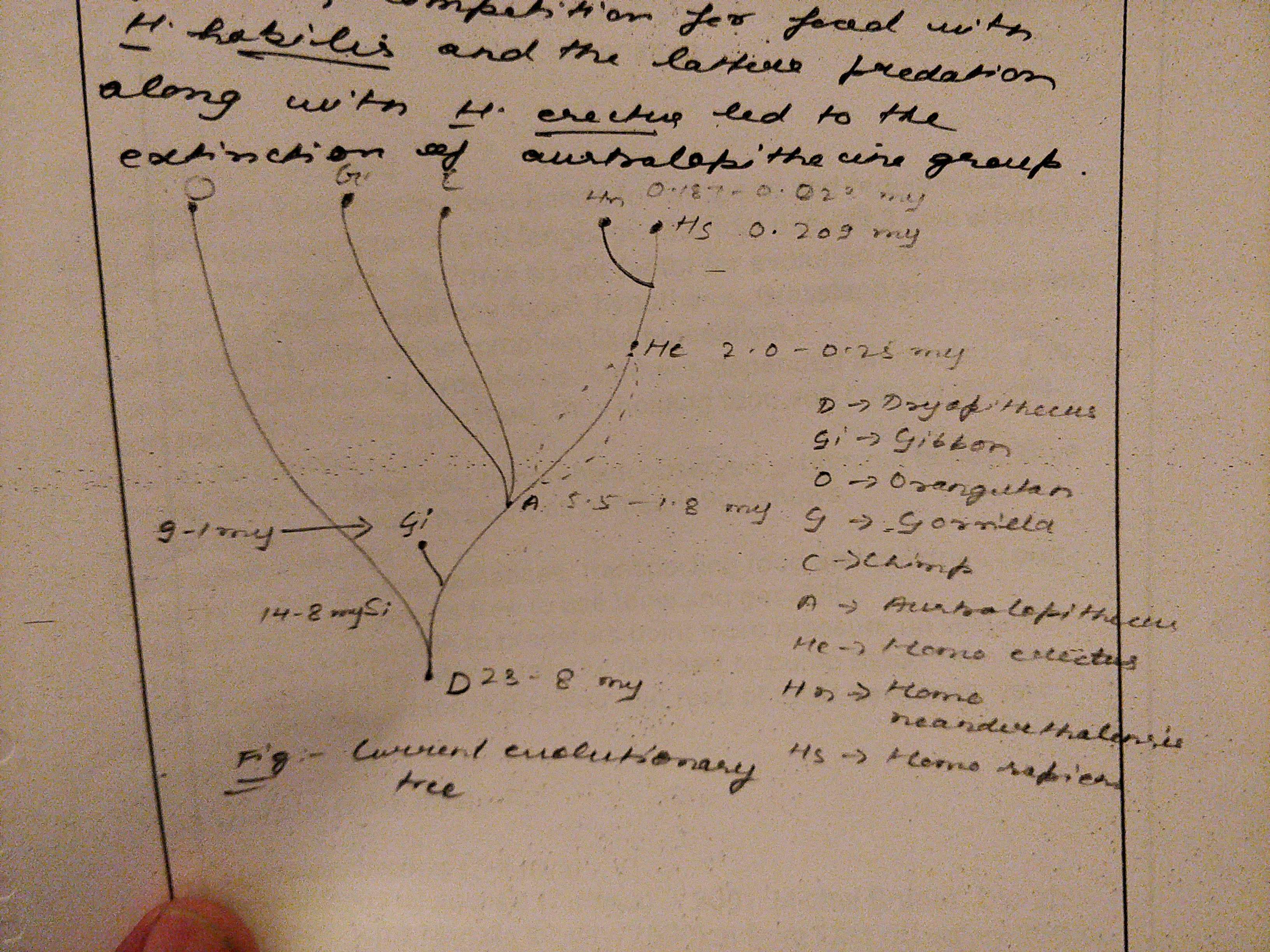
Eugene dubois set background for paleo anthropology and study of early human evolution.
Habilis
•2.5 to 1 mya.
•First homo
•Found in East Africa and South Africa. OH 24 or Twiggy in Tanzania 1968 1.8 million years ago. Less protruding face and larger brain.
•OH 7 Tanzania 1960 1.75 million years ago small dental size, increase brain size.
•Louis leakey Philip Tobias and John Napier studied and described as homo habilis from Tanzania Kenya Ethiopia Malawi and South Africa.
•homo habilis found on eastern side of lake turkana is called homo Rudolphensis. It is bigger than homo habilis.
•Smaller chewing complex and larger brain. Rounded skull. It Tim White studied differences between homo habilis and australopithecine and suggested that australopithecine garhi was its ancestor because says Jo and teeth are mostly similar. Transition took between 3 and 2.5 million years ago.
•Donald Johnson 1980 discovered skeleton apart from skull. Bipedal short leads in comparison to arms.
•Intelligence and use of tools. Large brain small chewing muscles and smaller teeth then australopithecines. Dependence on tool used indication.
•stone tools are more common in homo habilis sites than australopithecus sites. Cognitive advancement proved by increased tool making and tool used. It tools were fundamental to their survival. Diverse diet.
•warming around 2.5 million years ago increased habitat diversity and increased food resources for homo habilis. Therefore it had died versatility.
•650 cc
Homo erectus
•1.8 mya to 300,000. Earliest Fossil by eugene dubois. Trinil Java.
•Large brow ridges, long and low skull. Bigger brain
•Left and colonized Asia and Europe.
•Maeur alps.
•Boxgrove UK
•Dmanisi Georgia
•Zhoukoudian China
•Trinil Java
•Olduvai Tanzania
•Homo erectus Africa. 1.8 and three hundred thousand.
•Some australopithecines also around.
•Nariokotome, Westside Lake turkana 80% Juvenile skeleton point 1.6 m y a. Turkana boy 1984
•Short arms and long legs. Committed to terrestrial life with fully modern stride. Absence of sagittal crest. Smaller molars and thinner enamel reflecting soft diet. Some had robust bones while others had Gracile.
•Ilret footprints. Koobi fora footprints in Kenya. Just like modern human walking. Double arch, adducted big toe. long distance walking running and hunting very likely.
•Other fossils from Olduvai Tanzania.
•1.2 mya. Daka place. Bodo 0.6 mya. very robust with thick cranial bones and large Browridge.
•Tim white sound linear marks on the left cheek with microscopic analysis it was caused by stone tools which means some ritual cannibalism. Ritual defleshing. OH 9 Fossil.
•
First hominin migration
Homo erectus Asia. First 1890 Eugene.
•earliest evidence is 5 skulls bones and tools in Georgia by Georgian paleontologist David L - Dmanisi. 650 cc brain size and large face. 1.8 mya. Asia. Compared to African homo erectus they had faces and job smaller and Browridge less developed. But very e similarities in other areas like mandible of ilret skull. Leg bones longer than arms.
•Kocabas village Turkey five hundred thousand years ago Fossil found. Massive brow ridge and sagittal keel. Signs of tuberculosis.
•Sanigiran Indonesia. 1000cc brain capacity with thick cranial bones and large brow ridges with slight sagittal keel similar to homo actors of Africa Asia and Europe. Large brain and small teeth.
•therefore rapid spread from Africa to outside due to better intelligence reliable on on the material and social behaviour. Diverse diet.
•Gongwangling Fossil Shaanxi province. 1.2 million years ago. Well developed brow ridges and thick cranial bones with 800 CC capacity. Animal bones with butchery marks and stone artefact are found by RX Zhu.
•Zhoukoudian. 1200cc. 1920 discovery 1940 excavation. 87 80000 years ago. 40 to 50 individuals. Stone tools and food remains. Franz Weidenreich.
homo erectus Europe. 1.2 till four hundred thousand ya
•Earliest from Western Europe, Sierra de Atapuerca Spain. Cave site of Sima del elefante 1.2mya. Also Gran Dolina 900,000
•Partial mandible and some teeth. Animal bones with cut marks from butchering. Many stone tools. Animal bones broken which means food was processed before consumption.
•Mauer jaw mandible and mostly teeth from heidelberg Germany five hundred thousand years ago.
•Boxgrove UK.
Homo erectus biological changes
•Increase body size from homo habilis. Heavier. Henry Mark Henry and katherine coffing - height increase by 33%. Mostly changes between 2 and 1.7 m y a.
•Body changes due to climate change and food supply. Adaptation of hunting and meat processing provide better food and nutrition.
•Pat Shipman. Olduvai gorge butchering and scavenging of animals was observed not hunting.
•Tools and social organisation allowed better food supply. So show body changed. Advance in tools and Society E due to brain expansion and complex Technology.
•Acheulian 1.8 mya. more sophisticated and made from wide variety of raw materials into greater range of tool types and functions. Different in variety raw material types and functions from Oldowan tools. Middle awash Valley of Ethiopia shows tools used to kill large animals like hippopotamus.
•Practice anthropology. Glynn Issac matched the microscopic real pattern of tools by watching the animals and they were the same as acheulian tools used by homo erectus.
•homo erectus versus habilis point reduction in teeth size. Face and jaw reduction relative to braincase. Increase brain size. Browridge increase. Thick cranial bones. Body increase size. Reduced arms in length. Increase in length. 650 versus 950 CC brain 33% increase. Brain is energy expensive and nutrition resulted from meat which is protein rich.
•Use of fire point 1 million years ago. F Berna from South Africa -Wonderwerk.
•Zhoukoudian fire evidence. Pyre allowed expansion of humans in cold regions.cooking made easy to chew and powerful Joe and large teeth were not necessary. Therefore middle pleistocene hominin head smaller jaw and teeth. food sharing in social organisation also allowed better nutrition for all.
Homo erectus pattern of evolution.
•Skull. Long low and wide at base point thick bone and large brow ridges.
•More robust with largest and thickest cranial bones. Sagittal keel present in in African homo erectus.
Feldhofer cave neander Valley Germany. 1856 discovery. Hermann studied the fossils and reported his findings. found some RK human features. Skull was long and low but similarities like brain size.
modern man has high and vertical forehead round and tall skull. Small Browridge. small face small teeth and projecting chin called mental eminence. below the neck modern humans are more glacial, narrower bones.
Archaic Homo sapiens had longer and lower skull. Larger brow range. Bigger and more projecting face. Taller and wider nasal aperture. Projecting occipital bone called occipital bun. Larger teeth and no chin. Thick post cranial bones. Eg. Skhul and herto hominins. 500,000 to 350,000.
Homo sapiens sapiens 160,000 to 25,000
Australopithecine vs apes |
Australopithecines versus apps
- Bipedalism. Mastoid process. Pelvis. Legs. Locomotion knuckle walking or ground walking versus bipedalism. Curves in the spine. Broad and wide pelvis.
- Cranial capacity just higher
- Areas of skull associated with speech site frontal lobe temporal lobe developed than apes. No sagittal crest
- Robustus has simian shelf and sagittal crest. Less parabolic dental arcade
- Supra orbital ridge bigger in apps.
- Forward placement of foramen Magnum.
- Tool culture possibly advanced
New archaeology 1 |
Processual archaeology or "the new archaeology"
led by Lewis Binford in the 1960's, this was a critique of the culture history method of "describing" a culture. Binford argued that we should not identify cultures and place them in a chronological period alone, but we should "Explain" why that culture was manifested in that way. To explain processes of culture change, we need to take a positivist approach. this means we must be scientific, develop hypothesis that can be tested, gather data, and test them! this also involves
- Systems theory, the idea that culture is a system with subsystems that interplay to form processes. these systems can be broken down into mathematical units and statistically analyzed to identify patterns. Middle range theory is a big player here as well. this is the idea that we can find similar patterns, be it in the archaeological record, or through ethnoarchaeological analogy, that reveals the processes of how archaeological material ends up manifested as it does. the goal is to be able to form generalizations in cultural processes, otherwise known as laws in other scientific fields. this scientific approach leads to "objective" conclusions.
Post-Processual
The post processualists were mainly a critique of the processulists claims of "objective" conclusions.
- Ian Hodder, michael shanks, and others, argued that we can never come to an objective conclusion. political and social biases will always show through.
- they also argue that the individual is left out in the processual methods. the agencies of individuals are just as likely to create culture and bring about change through symbols and material items. therefore, archaeology needs a subjective, or interpretive approach that acknowledges the individuals role.
Processual archaeology has a method, the scientific approach to reach objective conclusions about cultural processes.
Post Processual archaeology really only critiqued that method. the researchers from that camp have interpretive methods of their own, but they never actually countered the processual method with what they would call a better one.
Culture change may be due to processes like climate change or ecology chagnge this happened coz that happened
Post processuralism says culure changes due to individual, their meaning, human nature. may’ve stumbled upon or change life due to competition or invent irrigation
Ethnoarchaeology 1 |
Ethnoarchaeology
Ethnoarchaeology AIMS explain behavioral traditions of early human past, by discovering irregularities in contemporary present. MLK Murty.
Its basic principle is using analogy of present to explain the past like comma traditions, material culture, substance, land use, settlements, craft specialisation, trade networks, rituals and so on. But it should also be backed up by non analogical grounds.
C Sinopoli. 1991.
Main topics.
- Site formation and depositional process.
- Studying traditional technologies and community settlement patterns.
- Human environment relation.
- Material implications of social systems, ideologies and beliefs.
Studies. Pick one.
- Paddya 1981. Acheulian culture of hunsgi baichbal valley. argued that groups gathered around the area in dry season and dispersed during wet season. Like chenchus of Krishna Valley.
- Shanti Pappu korttallayar basin Tamil Nadu 1997. Explained middle and late pleistocene culture behaviour through ethnographic study of irulas hunter gatherers. Postulated that they had sedentary multi family residential bases.
- Kirti Jain 1993 coastal ecology study. Focus on Son Kolis. documented their fishing knowledge, technology, settlements, traditions religion and social political organisation. Her study showed historic process through which Marine fishing groups adapted and rescheduled their strategies.
- Cooper 1994 Andaman Islands. Onge studied and explain formation of shell middens.
- Murty studied hafting, fishing tools, harpoons and traps of present communities to draw parallel to upper paleolithic and mesolithic blade tools.
- Murty 1980. Documented birappa legends of kuruva pastoralists of Andhra Pradesh to understand origin of pastoralism origin in 3rd millennium BC.
- Mishra 1994 Rajasthan. Studied symbiotic Association of different groups jats agriculturalists, rabaries breeders of camels, potters carpenters and hunting community Van Vagris nomads.
Malti Nagar 1970 studied ahar culture of chacolithic complex of Ahar culture banas Valley which is similar to to present a pottery in the region. She noted that design garments of bhil women are similar to designs of ahar pottery. Provided understanding of regional traditions and craft specialisation.
Ansari studied mesolithic and chalcolithic culture of Ganga and belan Valley with current tribes in the region kol and Mallah. Studied their settlements, architecture, food refuse etc.
Art and craft. Saraswati 1978 studied potters, stone workers, metal casters in South Asia to study relationship between producers and consumers and their distribution and exchange system. This explains archaeological distribution of materials. Concluded that at North Indian pottery has continued from Harappan times till present.
Criticism
Cannot make generalisation from single case. C Sinopoli. 1991
Should not view India as static and tribal culture is always changing.
Material parallel do not always demonstrate social cultural and behavioral parallel. Allchin 1985.
The environment has also changed.
So, ethnoarchaeology is not a blue print for the past but a framework to understand the past.
India Mesolithic |
India Mesolithic
- 10000 and 4000 BC
- Climate variation. Teri and langhanj arid. Bhimbetka wet and tropical. Didwana fresh water.
- Pot sherds
- Domestication hints at bagor, adamgarh. Goat cattle.
- Settlement sites
- Blade Technology at Teri.
Pre australopithecine |
Pre australopithecine
Chimps diverge 8 mya
Pre Australopithecines (7-4 mya)
- Sahelanthropus tchadensis (7-6mya). - 2001. Michel Brunet. Djurab desert, chad. 2500km from East rift valley
- 350 cc brain.
- massive browridge.
- foramen magnum backward
- non honing complex.
- diverse diet.
- forest habitatnear lake.
- Orrorin tugensis 6mya. tugen hills. kenya. bipedal curved phalanx. non honing complex.Ardipithecus Kadabba & Ar. ramidus. (6-4 mya)
- Awash valley Ethiopia. Tim White found. 1980s. 70 scientists. continuous record of hominin evolution. Mosaic evolution features. ardi = groud & ramid = root.Ardipithecus - complete skeletons found. Ecological details found. 4ft tall.
- Lived in forest not grasslands.
- omnivorous diet.
- Hominin masticatory conplex. Non projecting canines. Thicker enamel. Big toe opposable. Curved phlanges and rigid foot so poor bipedalism.
- No suspension bone type in elbow. Evolved pelvis. Forearm extraordinary long.
- longforearm than humans - primitive. pelvis developed. lower limbs have elongated divergent toe for grasping but also for bipedality. Mosaic evolution in ardipithecus.
- Enamel thinner than man. big toe opposable - unlike man. phlanges curved to grasp. So part time quadruped & part time biped.
- But had giving features and arboreal traits.
Primate evolution |
Primate evolution. Larsen 2016
- First 50 million years
- Paleocene 66 to Miocene 6mya
- Why primates evolved. Elliott Smith arboreal hypothesis 3 requires grasping hands binocular vision for depth.
- Cartmill hypothesis visual predation on insects and tree branches.
- Sussman fruit eating hypothesis.
- First primate plesiadapiform. 66mya. But do not have post orbital bar, convergent orbitals and grasping hands or nails. So, rejected. Specialised teeth
- Eocene 56 to 34. Climate change. Warmer. Adapids and omomyids. In US Africa Europe Asia
- Clear primate characteristics like postorbital bar. Convergent ise. Grasping digits. Nails on digits. Non-specialized. Large brain to body size. Various diet.
- Omo for tarsiers. Adapids for anthropoidea.
- 63 mya separation from strepsirhini and haplorhini.
- Features of eocene primates. convergent eyes. Small incisors. Increased vision. Partially or fully closed eye orbits. Large canines. Nails on the digit. Grasping digits. Short snout and increase brain.
First anthropoids
- Eosimians. 42 mya. Jiangsu province of China. As per Christopher beard. Dawn monkey. Similar ankle bones. Tarsal similar. Upper canine and and upper jaw similar to monkey. Calcaneus short.
Oligocene
- 34 and 23. Rapid cooling.
- Fayum most found.
- Oligopithecids. Parapithecids. Propliopithecids. 35mya
- Parapithecids. 3 premolars. Direct link to platyrrhine. they may have evolved in Africa and migrated to South America. Migration across Antarctica to South America possible. Small size squirrel.
- Aegyptopithecus. Sagittal crest. Equal size of front and Hind limbs. Arboreal quadruped. Ancester of Catarrhines. 2123. 35 to 33mya
- Nancy Stevens point genetic clock shows that apes and monkeys originated in early miocene between 25 and 30 million years ago. Tanzania rift Valley.
Miocene. 23 to 5 mya
- Warming Trend.
- Proconsulids. 22 to 17 mya. Hominoidea. P. Major. P. Africanus.
- 50 kg. Rusinga Island Kenya. Hopwood 1933. fossil by Leaky. Y5 molar. wild and rounded kasht point honing surface on back of upper canine and front of lower third molar. Diet of nuts and fruits. Post cranial anatomy like monkeys. Equally long limbs. Did not have working for swinging specialisation. Limited wrist mobility. Quadrupedal.
- Apps versus proconsul is that apps have highly mobile shoulder joint. Shallow rib cage. Greater elbow extension. Arms longer than legs. Large hands.
- Dryopithecus. Euro France Spain. Discovered by lartet 1856 st gaudens France lower jaw. Later by mary leaky. Resemble modern apes.
- Sharp canine. Teeth long and good for fruit chewing. Larger brain. Brain size similar to modern chimpanzee. Long four limbs. Grasping feet. Y5 molar cusp. 25 to 33 pound wt. Interlocking canines.
- Simian shelf indicated. 160cc. Not specialised locomotion.
- 13 to 8mya. D sivalensis for orang possible. D. major. D. africanus.
- Today D. fontani.
- Distributed across Europe. France Spain Greece
- Sivapithecus. Asia India Pakistan China
- Orangutan and syster. 12 and 8 million years ago. Enamel thick. Robust jaw. Because of enamel it was believed to be human ancestor. Rejected by pilbeam 1979 and Shah discovered partial skull. concave face. Narrow nasal bone. Oval eye orbit. Projecting premaxilla. Large upper Central incisors. Khoratpithecus 9 to 6 Mya possible ancestor of orangutan
- Gigantopithecus. 3 metre tall 300 kg thick enamel teeth. 8 to 5 Mya.
- Oreopithecus. Swamp ape. 8 to 7 mya. Tuscany italy. Possibly extinct due to climate change. Suspensory locomotion.
- Victoriapithecids. Old world monkey ancestors.
- At this time climate was changing tectonic shift. Himalayas Alps and East African mountains creating. Europe African tropical forests became cool and dry Woodlands and grasslands. Changing diet fruit rainfall temperature.
Why bipedalism evolved |
Why bipedalism
Hominin evolution
Hominins.
•bipedal & non honing chewing. main features.
•secondary features. foraman magnum downward to bottom of skull. S shaped spine, ilium is short from front to back. legs loger than trunk & ARMS. HALLUX NOT OPPOSABLE BIG TOE. reconfigure gluteal muscles. angling of knees helps put feet below centre of gravity. arches on foot absorb shock. efficient walking.
•non honing. no diastema(canine fits between third premolar & lower canine - this hones the canine & keeps it sharp), small incisors. small blunt non projecting canines. thicker enamel.
Why hominins evolved
•Darling said bipedalism freed hands for weapons and reduced canine size. Increase intelligence and language. But tool use @3.3 mya & biped 6-8 mya. hunting also @ 2mya so not factor for evolution earlier.
•Rodman & McHenry patchy forest hypothesis. Grassland and forest with habitat lead to efficient locomotion like bipedalism.
•Lovejoy provisioning hypotheisis. Mother's depended on meals to give them food. So males gave food, thus holding food and bipedal walking. natural selection.
C neimitz. Amphibious lifestyle.
•Philip Reno. Little sexual dimorphism observed in hominin bones. Thus cooperative behaviour present as primatolo9gy shows.
Bipedalism benefits
•Ability to see greater distances. transporting food and children. Long distance running. Hands free to use tools and get skills.
•Negatively. Vulnerable to predators point more pressure on vertebral disc. Cause of injury. More pressure on heart to pump blood from the lens. It if one the person is disabled. But read of must have been very good.
Adaptive radiation in primates |
Adaptive radiation in primates
- 25 separation from monkeys. Chimpanzee 8
- Strepsirhini. wet rhinarium and heightened sense of smell. Specialised diet. Nail and claw toilet on second digit. Tooth comb
- Lemuriformes
- Lemuroidea
- Lorisoidea
- Haplorhini. Larger brain. Sexual dimorphism. Dry rhinarium. Les teeth. Convergent eyes. Colour vision.
- Tarsiformes. Tarsier. specialised diet. Large bulbous eyes for nocturnal version. Elongated tarsals for giant leap. 2 inches and restricted to Philippines area.
- Anthropoidea
- Platyrrhine
- Ceboidea. Arboreal. Suspensory locomotion. Prehensile tail. Diverse diet insect fruit leaves.
- Cebidae
- Atelidae
- Catrrhini
- Cercopithecoidea. Arboreal. Biphodont upper and lower mola. Narrow face. Sitting pad on hips. Non prehensile tail. Sexually dimorphic canines.
- Colobus
- Cercopithecinae
- Hominoidea. Y5 lower molar pattern. large brain. Broad face. No external tail. Usually long forelimbs than hindlimbs. Omnivore.
- Hylobatidae. Gibbons Siamangs
- Hominidae
- Ponginae
- Gorillinae
- Homininae
- Panini
- Hominini
Nocturnal. Insect eating. Wet nose. Claw on the finger for cleaning. Little lies. Leaping locomotion vertical clinging.
Diurnal. Prehensile tail. Swinging branch living. Various diet. V shaped dental arcade.
EPS 11 ground entries. Nakal walking or or brachiation. No tail. U shaped dental arcade. Diastema.
Bipedalism. Different diet. Loss of body hair. Parabolic dental arcade. Hi cranial capacity. Precision group. Length legs longer than hands. Child maturation time is height.
Prosimians. 2133
New world monkeys. 2133
Old. 2123
Denisovan and luzonesis |
Primate behaviour |
Primate behaviour. Goodall.
- Social organisation
- Monogamy in gibbons. Social bonds. One male multiple females in gorillas.
- Stool culture
- Language and communication
- Altruism
- Hunting.
- Wilson believes primate behaviour influenced by natural selection
- Dimorphism when males compete for females.
- Competition to meeting infanticide. Hierarchy among females as well as males.
- Hamilton. Kinship grooming activity and cooperation.
- Female more burden for food and child care.
- Jane goodall. Teej each other 2 cracked nuts.
- Klaus Z. Vocal communication and sounds for rivals snakes tiger. Nonverbal gestures
- Dr Rumbaugh. Consider the app. Koko the Gorilla sign language.
- But only upto a limit nim chimpsky.
Separation. 25 million years ago monkeys point 14 million years ago old world and new world monkeys. 18 gibbons and see among. 14 orangutan 12 Gorilla 8 chimpanzee. Larsen 2016.
Evolution timeline |
Evolution timeline
- Aegyptopithecus primate ancestor of Catarrhines
- 25 million year ago separation from old world monkeys. 14 separation of colobinae langur and cercopithecinae baboon and macaque
- 18 million year ago separation of hylobatidae. Gibbon Siamang
- 14 orangutan 12 Gorilla 8 chimpanzee.
Why study primates |
Why study primates. multidisciplinary involves Anthropology zoology sociology psychology biology. Robert sapolsky, Sue Rumenbach, Jane goodall.
- Language. Koko kanzi
- Society family institution of marriage kinship
- Vaccination of polio
- Ecological relations
- Evolution of tool culture. Capuchin.
- Conservation
- Behaviour and cognition.
Humans position |
Humans position
Primate
- Ungulate. Flat nails on digits.
- Brain with posterior lobe and calcirine fissure
- Eye orbits surrounded by bony rims.
- Well developed clavicle
- Penis pendulous two pectoral mamae
- Thumb or great ties or both opposable.
- Three sets of teeth at any stage of life
- Prehensile limbs
- Well developed cecum
- Binocular vision. Reduced snout.
Prosimii vs Anthrpoidea
- Claw vs nails
- Tree vs ground. Brachiation and slow quadrupeds.
- Brain. Cerebrum small, less complex vs bug and complex
- Foramen magnum backward vs forward
- Eyes lateral vs forward
- Better olfaction. Better vision.
- Lack seperate mobility of fingers.
- 2.1.3.3 prosimii. 2.1.2.3 anthro.
- Long moveable ears. Anthro pinna immovable
- Less developed facial muscles.
- Self made vitamin C vs exterior.
- Snout. Wet rhinarium. Vs dry and reduced snout.
- Nocturnal vs diurnal.
- Diet insects vs varied.
Hominoidea
- Cranial capacity.
- Dental formula u-shaped with 2123.
- U4 vs Y5 cusp lower third molar.
- Forward movement of occiptal condyle and foramen Magnum.
- Tendency for erect posture.
- No prehensile taill
- Slender build.
- Locomotion. ground based living
- Producer single offspring.
- Longer maturity time for the child.
- Separated from monkeys 25 million years ago genetically
Chimp and gorilla vs man
- Cranial capacity. Bipedalism. Dental arcade. Pelvis. Spine curvature. Foot design. Hands.
Divergence from old world monkeys At 25 million years ago oligocene miocene period. 18 to 20 million years ago gibbons diverse. Orrington 12 to 16 Gorilla 6 to 8 chimpanzee 4to 6.
Locomotion adaptation |
Locomotion adaptation
- Millions of years of adaptive radiation among primates has created different locomotion as per their behaviour and environment
- Napier and Napier 1967
- Bipedalism. Humans. Long legs. Big toe is not possible. Double arch and erect posture.
- Vertical clinging and leaping. Galagos. Tarsiers. Strong hind limbs for propulsion. Elongation of hind limbs.
- Brachiation
- True brachiation gibbons. Suspended and swinging movement very fast.
- Modified brachiation. Orangutans. Slow movement and movement by hanging.
- Quadrupedalism. Both fore limbs and Hind limbs used.
- On ground.
- Knuckle walking Gorilla. Long arms long fingers and short thumbs point habitually bent knee.
- Ground walking baboons
- Arboreal
- Branch running and walking marmosets. Aye Aye. Hind limbs and forelimbs almost equal. Use tail for balance.
- Semi brachiation.
- Old world langoor. Elongated arms and swing beneath branches.
- New world spider and howler monkeys. Prehensile tails
- Slow climbing Loris. Big toe splayed out. Powerful grip.
Sohanian vs Madrasian culture |
Sohanian vs Madrasian
- Sohan culture represented by peddle tools are chopper chopping tool tradition. Robin Dennel 1980 raised doubt about this.
- Also found in ghaggar, Sirsa, Hoshiarpur Chandigarh region. But they also have acheulean tools.
- Riwat and utrarbani. 1.8 to 2 mya date.
- Oldwan tradition
- Madrasian. Buy facial for hand axe cleaver culture. usually quartzite but also basalt in Maharashtra. Granite in jhansi.
- Kurnool cudappah,
- 1.8 mya attirampakkam.
- some contest that acheulean tools may have originated in peninsular India itself.
- it was believed that Central Narmada basin was the meeting point of these to culture Krishnaswamy 1951. But later it was revealed that no sufficient evidence for or these culture as distinct groups Jaiswal 1978. Acheilian artefacts are found in sub Himalayan region where chopper chopping is dominant and vice versa. Mohapatra 1990.
Apes vs man |
Apes vs man
- Cranial capacity 500cc versus 1450 cc
- Sagittal crest present versus absent
- Dental arcade u-shaped versus parabolic
- Forehead sloping versus 90 degree
- Cranial capacity more than facial capacity in humans
- Backward placed foramen Magnum vs forward.
- Supraorbital torus present versus absent.
- Presence of large canines jaw and diastema.
- Neck is thick strong and stout. Versus cylinder and gracile.
- No capacity for language speech versus well developed Hyoid bone.
- No curves in the spine versus s-shaped spine
- Knuckle walking aur partial bipedalism versus full-time bipedalism
- Power grip versus precision grip
- Capacity for limited language finite and closed. Versus infinite and discrete
- Tool used limited versus unlimited tool use
- Arms are longer than legs. Versus short arms
- Flat foot versus double arch in the foot
- Absence of Linea aspera vs presence.
- Pelvis is elongated and narrow versus broad and short pelvis.
- Opposable hallux vs opposable pollex.
- Apps have better short term memory man has long term memory.
Similarities
- Large rounded cranium. Reduced prognathism. Dental arcade shifting from V to the shape of you. Wi-Fi kasht pattern. foramen Magnum and hospital Gondal show forward movement. Three hands I'll hands and digits can move separately. Sternum flat chest thoracic prolongation. Lack of externally visible tail. 98% closeness with chimpanzee Gorilla 97% orangutan 96%.
Monkeys vs hominoidea |
Monkeys vs hominoidea.
- Cranial capacity.
- Dental formula v-shaped with variation like 2123 2133 2132 vs Dental formula u-shaped with 2123.
- U4 vs Y5 cusp lower third molar.
- Forward movement of occiptal condyle and foramen Magnum.
- Buchal pitch vs none.
- Tendency for erect posture.
- Prehensile tail or tail
- Slender build.
- Locomotion. True brachiation and life suited for the trees. Verses ground based living
- Monkeys have large groups.
- multiple offspring at a time versus single offspring.
- Shorter vs longer maturity time for the child.
- Separated from monkeys 25 million years ago
Similarities. Anrthropidea
- Forward placed eyes and completely e surrounded by bony rim
- Reduced prognathism. Dry nose and reduced olfaction
- Nails.
- Digits mor controllable and power grip.
- Diurnal
- Pinna immovable
- Diet varies.
Anthrpoidea apes |
Anthrpoidea apes.
Diurnal. Varied diet. No tail. Nails on digits. 2.1.2.3. Large size. Dry rhinarium.
- Hylobatidae
- Gibbons and see among. Lesser apps. Asia. Long arms for brachiation. Wrists have ball and socket joint. Small size 14 kg. Low sexual dimorphism. Small social groups.
- Hominidae
- Knuckle walking. arboreal and ground lifestyle. 400 to 500 cc cranial capacity. Significant prognathism. Buy steamer. Social animal with powerdrift. capacity for symbolic language Koko the Gorilla. Use of tools Jane Goodall. Arms longer than legs. U shaped dental arcade. Poorly developed facial muscles than humans. Nose is not pointed.
- Gorilla
- Orangutans.
- Chimps.
- Bonobos. Sapolsky.
- Humans. Not apes as per John hawks.
Divergence from old world monkeys At 25 million years ago oligocene miocene period. 18 to 20 million years ago gibbons diverse. Orrington 12 to 16 Gorilla 6 to 8 chimpanzee 4to 6.
Chimpanzee |
Chimos vs man
- Homininae. Sub family. Panini. Hominini
- 400 CC vs 1450 cc
- Facial angle 60 to 70 degree
- Sloping forehead. Supraorbital ridge. Sagittal crest.
- Flat and receding occipital region. Bulbous in humans.
- Foramen Magnum backward placed
- Large canines and diastema
- Facial capacity more developed than cranial capacity
- Dental arcade u-shaped.
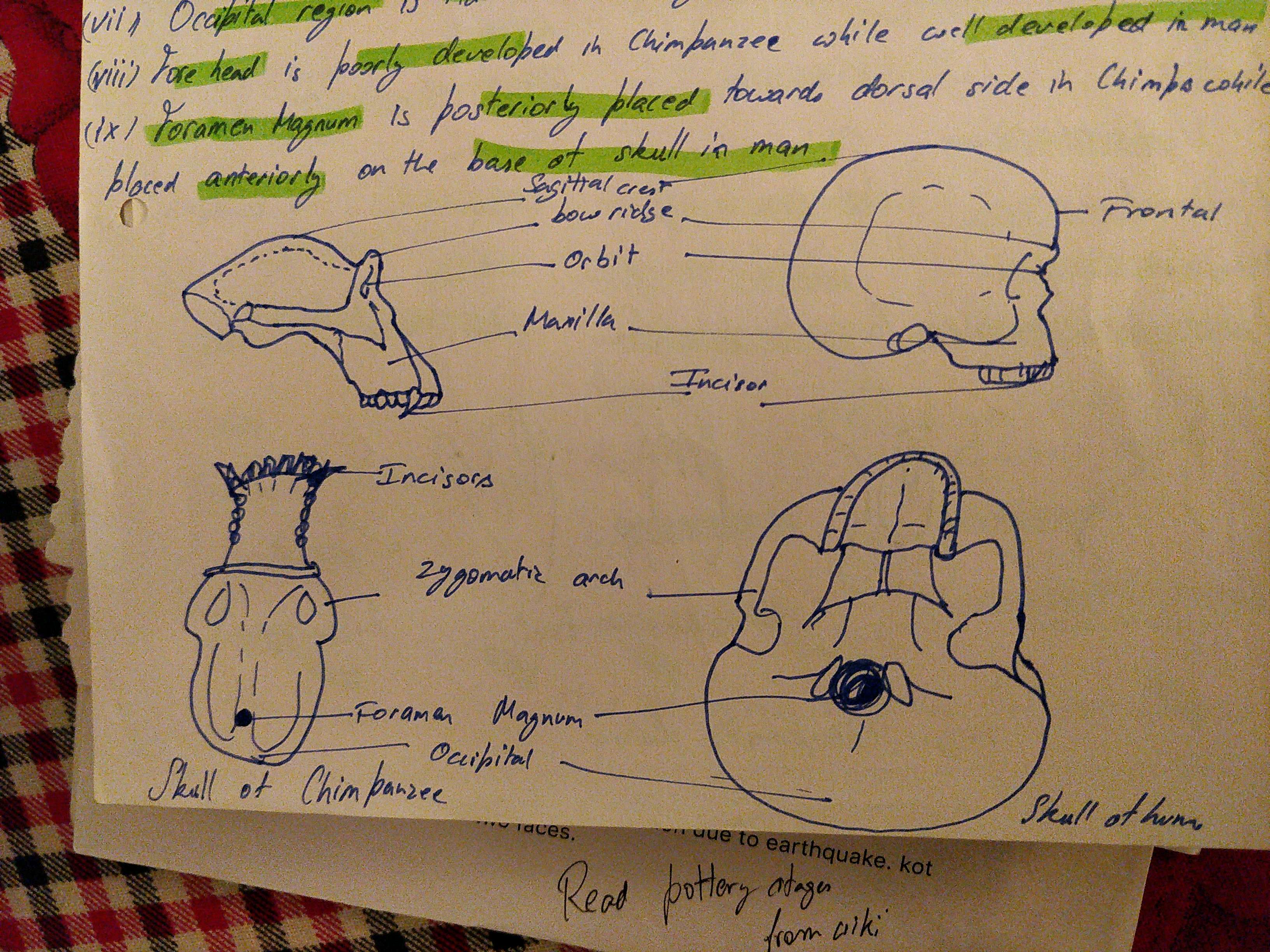
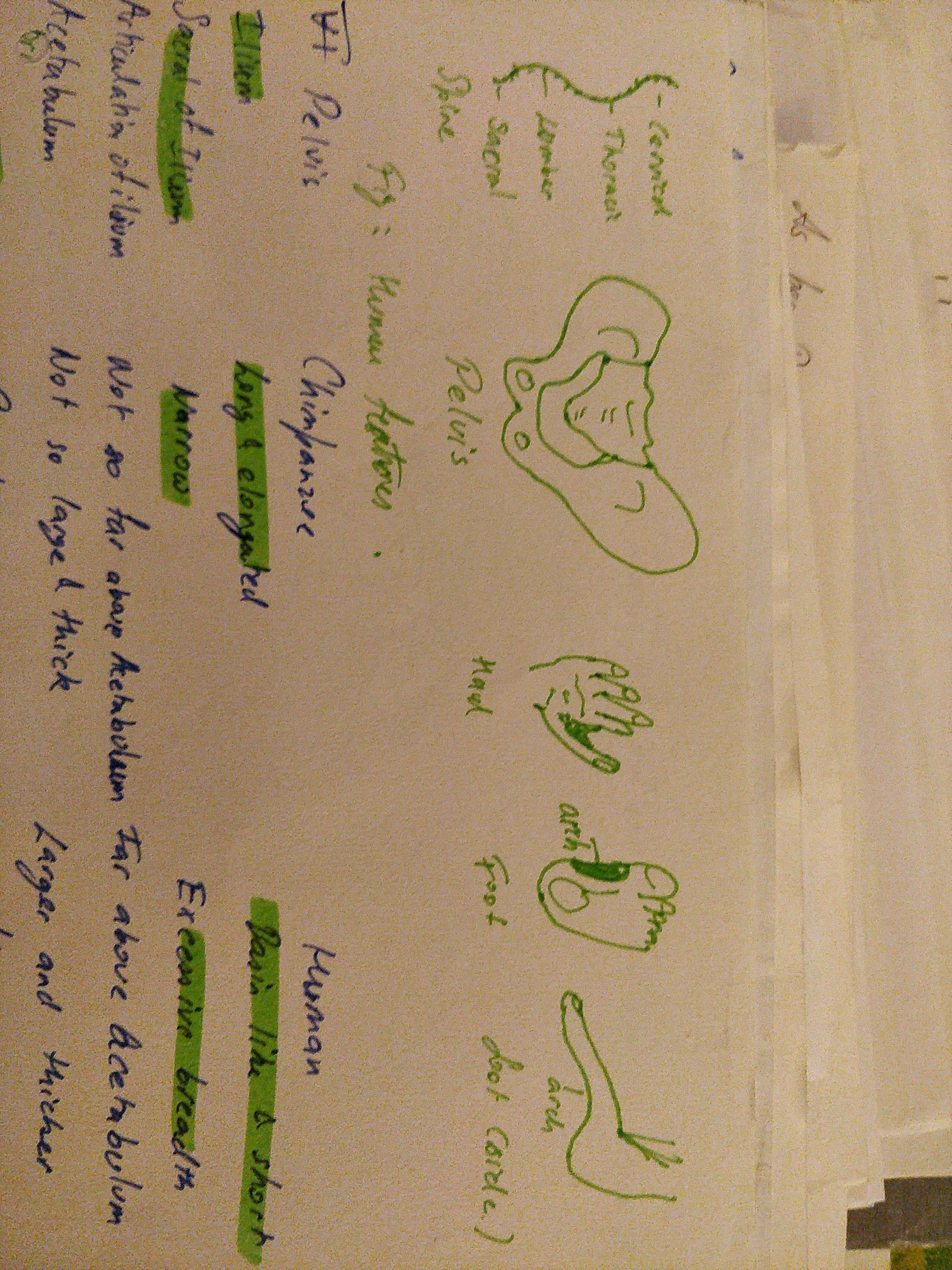
Nose
- Depressed and broad. Human prominent and elongated.
- Well developed zygomatic process. Not in humans
- Nasal bone thick and long.
- Nasal tip absent but present in man
Neck. Stout and strong
Chin is absent and simian shelf present. Large and massive mandible
Vertical column. Lacking curves. No precision grip. 13 pair of ribs. Long pelvis. Flat foot and poor opposibility of pollex and hallux. Sacral of ilium narrow in chimpanzee broad in humans. Brachial locomotion versus bipedalism
- Poorly developed hill. Absence of arches. Opposable big toe.
Primates |
Primates
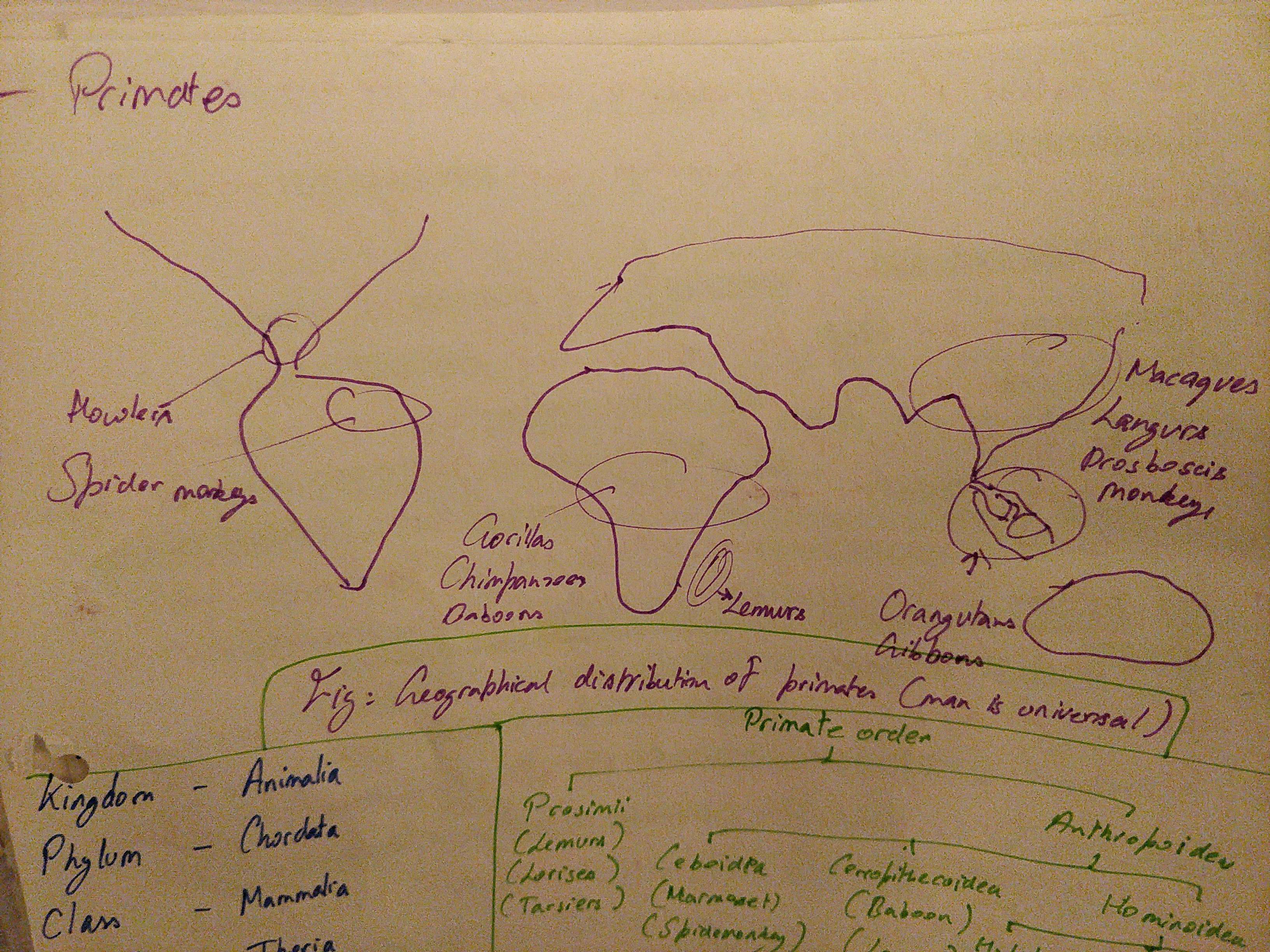
- Brain with posterior lobe and calcirine fissure.
- Eye orbits surrounded by Bony rim. Binocular vision. Nocturnal or diurnal. Reduced snout.
- Three set of teeth.
- Well developed clavicle.
- Easily rotate four arms and stretch legs more than other mammals.
- Padded fingers.
- Sexual behaviour not seasonal.
- Prehensile limbs
- Opposable thumb hallux pollex or both.
- Nails on the digit
- 2 pectoral mamae
- Simple stomach with well developed cecum
- Penis pendulous.
- Locomotion by brachiation quadrupedalism bipedalism.
- Long period of infancy and grooming and socialization. Complex social life.
Due to anthropogenic activities like deforestation poaching and climate change 60% of primates like lemurs orangutans and gorillas are under threat. Estrada et al.
Primates.
- Haplorhini
- Tarsifores
- Tarsiers
- Anthrpoidea
- Ceboidea
- X
- Cattrhini
- Cercopithecoidea
- Cercopithecinae
- Colobinae
- Hominoidea
- Hylobatidae
- Hominidae
- Gorrlinae
- Panininae
- Homininae
- Chimp
- Hominini
- Platyrrhine
- Ceboidea
- Cebidae
- Atelidae
- Strepsirhini
- Lemuriformes
- Lemuroidea
- Lemur
- Lorisoidea. Loris
Prosimii vs anthropoid |
Prosimii vs Anthrpoidea
- Order primate. Older classification
- Similarities
- Ungulate. Flat nails on digits.
- Brain with posterior lobe and calcirine fissure
- Eye orbits surrounded by bony rims.
- Well developed clavicle
- Penis pendulous two pectoral mamae
- Thumb or great ties or both opposable.
- Three sets of teeth at any stage of life
- Prehensile limbs
- Well developed cecum
- Binocular vision. Reduced snout.
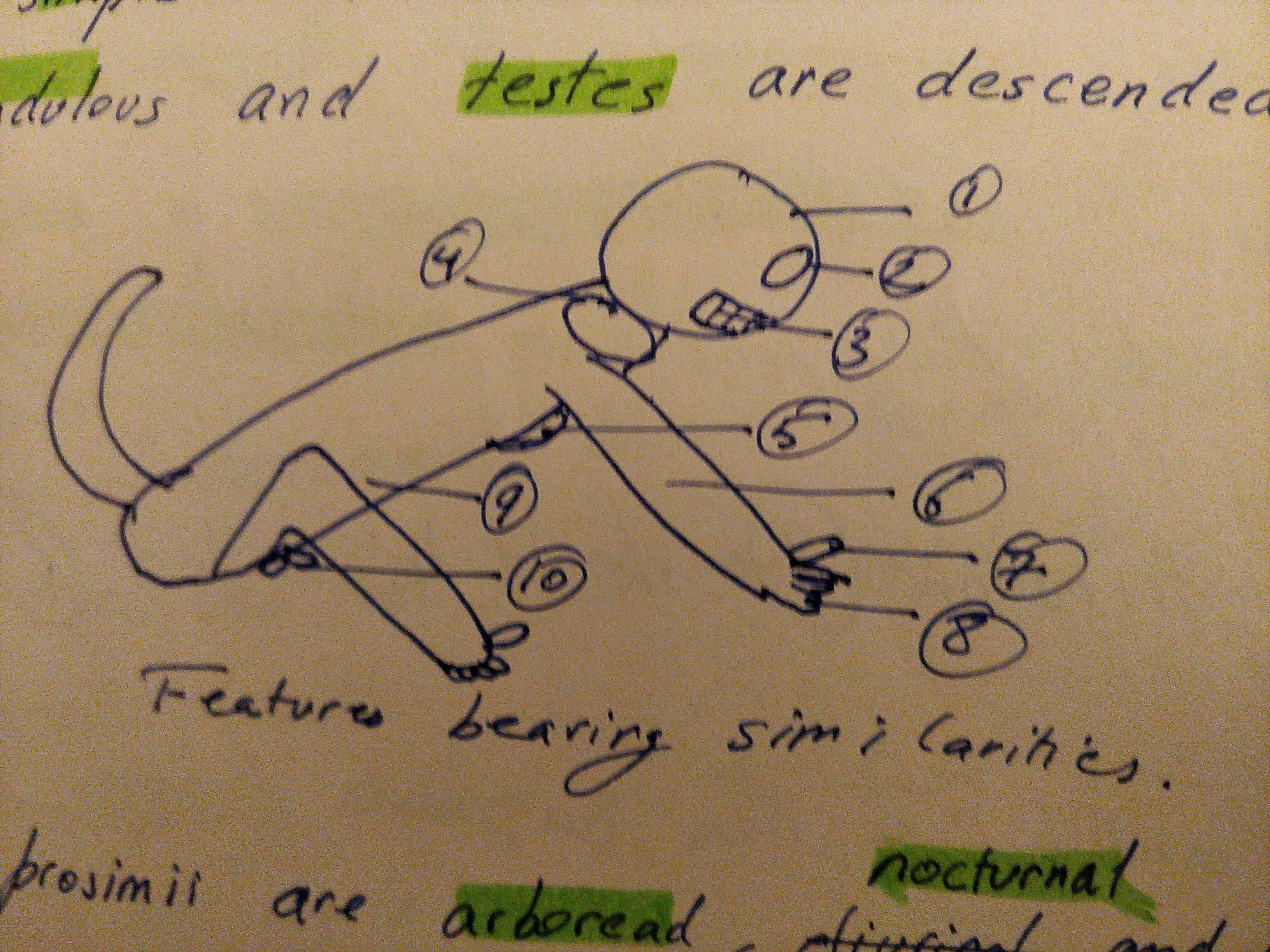
Differences. Prosimii
- Claw vs nails
- Tree vs ground. Brachiation and slow quadrupeds.
- Brain. Cerebrum small, less complex
- Foramen magnum backward
- Eyes lateral
- Better olfaction
- Lack seperate mobility of fingers.
- 2.1.3.3 prosimii. 2.1.2.3 anthro.
- Long moveable ears. Anthro pinna immovable
- Less developed facial muscles.
- Self made vitamin C
- Snout. Wet rhinarium
- Nocturnal
- Diet insects
Primate order 1 |
Primate order. O.S.I.P.S.F.S
- Sub order. Strepsirhini
- Lemuriformes. Infra
- Super family. Lorisoidea. Loris. Galago
- Lemuroidea. Lemur. Indri
- Haplorhini
- Infra. Tarsiformes. Tarsiers
- Infra. Anthrpoidea
- Parva Platyrrhine. New World monkeys
- Superfamily. Ceboidea
- Cebidae. Marmosets.
- Atelidae. Howler and spider monkeys.
- Parva. Catarrhini.
- Superfamily. Cercopithecoidea. Old works monkey.
- Colobinae. Colobus Langur
- Cercopithecinae. Macaque. Baboon
- Superfamily. Hominoidea
- Hylobatidae. Gibbon Siamang
- Hominidae.
- Ponginae. Orang
- Gorillinae. Gorilla
- Homoninae.
- Panini. Chimos Bonobo
- Hominini. Homo
Dates |
66 Paleocene 56 warm eocene
34 cold oligocene 23 warm miocene
5.3 Pliocene 2.6 quarter Pliestocene.
Homo erectus culture |
Homo erectus
- Acheilian tools. More continuity and finesse. Quartz. Chopper chopping tools. Possibly bone and wood tools.
- Hunting economy. Excavation sites have many animal bones indicating hunting and group life. Ambrona Spain - Big game hunting elephants.
- Zhoukhudien. China. Evidence of fire. Charred animal bones.
- E hoebel. Cannibalism. Due to fracture skull from China.
- Language and communication. Group living.
- Rituals possible. Geometric engravings on shell. Joordenss 2014. Java fossils.
- Terra Amata site. House. Lumley.
Absolute dating |
Absolute Dating:
Carbon Dating -
- Radiocarbon dating is a chemical analysis used to determine the age of organic materials based on their content of the radioisotope of carbon 14.
- The method was developed by Willard F. Libby
- up to about 50,000 years.
- By radiocarbon method one can date different types of organic or inorganic materials as long as they consist of carbon.
- sunlight collides with nitrogen and creates carbon 14 isotope which animals consume in life. 14 and 12 ratio remains constant in life and decrease after death. Based on half life of carbon 14 we can estimate the age of specimen.
- Require large amount of sample. DK is dependent on statistical probability not always accurate. Costly method. Precision needed. requires dry conditions preservation. Contamination of specimen possible. Requires organic matter.
- Applied in Sarai nahar Rai mesolithic dating. 8400 bc.
Pottassium- Argon (K-A40) Dating - radioactive method.
- The earth's crust contains potassium of which isotope K40 decays to A40 at a known rate.
- The ratio of potassium to Argon may be measured to ascertain date of minerals and rocks in a deposit. half life of the radioactive potassium is 1330 million years.
- dating some hominid fossils as employed in the site of Olduvai Gorge in east Africa where the remains were as old as 1.75 million years.
- works well in case of the sites which are 500,000 years old.
- disadvantageof the method is that it can be applied to only to those rocks and minerals which are rich in potassium.
Thermoluminescence(TL) -
- Oxford by M. Aitken.
- Initially designed to date archaeological ceramics, it was subsequently extended to other mineral materials, such as burnt flint.
- This is based on the fact that objects such as pottery that have been heated in the past can be dated by the measurement of their Thermoluminescence (TL) glow.
- Thermoluminiscence (TL) is the emitted light in the pottery which can be measured. If the ground up pottery is reheated, it emits light. The phenomenon results from radio-active influence of the metallic elements like uranium and potassium present in the clay and surrounding soils.
- enabled in revising some prior assumptions about the evolution of lithic industries and the nature of hominids present in the Near East at various stages of the Middle Palaeolithic. Mousterian culture. Dating.
- 40 k to 200k range.
- Limitations. other factors also affect the strength of luminescent rays. Not very accurate.
Optical luminescence dating. Huntly developed it. Particles gain charge as long as they remain in the dark and under the soil. This tells us how long the object has been in the soil so it can be dated. Advantages, no heating of the sample required. Sample is preserved. Used in dating arrival of humans in Australia.
Obsidian daring
- 1960 freedman and Robert Smith.
- fixed rate at which freshly exposed obsidian surface absorbs moisture from environment point in the course of making tools, table exposed fresh surface of Rock to the moisture. By measuring how deeply the moisture has penetrated into the obsidian researches candid the length of time since the tool was made.
- Used as relative and absolute dating method both. Less expensive than radiocarbon dating. Abundant findings.
- Limitations. Local environment various changes in moisture. Error is hai.
Dendrochronology - AE Douglas.
- The age of wooden objects can be determined by means of Dendrochronology or tree ring analysis. It determines the calendar years of tree-ring formation and the felling dates of trees, which helps to determine the age of wooden objects with a great precision.
- Dendrochronology has therefore become well established in the field of archaeology, art history and cultural heritage.
- The method depends on the fact that trees growing in temperate zones have clearly defined annual rings of growth. As these tree rings represent annual growth, merely by counting rings one can count the age of the tree and hence its association.
- This dating method with latest methodological advances helps us in defining the calendar year in which the tree-rings were formed and in interpreting such dating in terms of the age of a wooden object.
Electron Spin Resonance (ESR) -
- In the last 20 years, the Electron Spin Resonance (ESR) dating method has allowed the establishment of a chronological time frame over most of the history of human evolution.
- Despite many difficulties found for ESR dating of bones and carbonates, tooth enamel dated by Electron Spin Resonance (ESR) has been proven as a reliable method in its application to fossil teeth and quartz.
- Both of the latter materials have allowed dating of Early and Middle Pleistocene sites which are not datable using other methods.
- In particular, recent discoveries of human remains in Western Europe have been proposed to be sites of the earliest arrival of humans there, and have been dated to the Early Pleistocene by Electron Spin Resonance (ESR) using quartz and tooth enamel.
- Electron Spin Resonance (ESR) method can be applied to different types of samples in various environments; its contribution to the elaboration of a chronostratigraphic frame is of a great importance for the understanding of the Homo erectus dispersals out of Africa and especially for the first settlements in Europe.
- Electron Spin Resonance (ESR) dates ranging between 1.7 and 2.3 Ma have been proposed for the South African sites Sterkfontein and Swartzkrans, indicating that the whole Quaternary period can be dated.
Palaeomagnetic Dating - Robert DuBois. 1960.
- earth's magnetic field in several places varies with time.
- When clay is heated to a certain degree, the magnetic elements of baked clay realign themselves along lines dictated by the intensity and character of the magnetic field of the earth at that time.
- On cooling the magnetic elements are frozen and can be recorded as long as the clay is preserved. This is called remnant magnetism.
- When records of past angles of declination and dip have been kept it is possible to compare the values of historic records and arrive at the date of archaeological specimens of fired clay.
- Fluxgate, Spinner magnetometer, Super-conduction magnetometer are the instruments used for measuring magnetic remenence.
- dating Karewa sediments in Kashmir.
- The reliability of the application of the method depends on certain conditions such as
- The availability of good records of change of magnetic paths near the prehistoric sites,
- Occurrence of series of already dated baked clay in the area against which objects of unknown dates can be dated,
- Availability of archaeological samples which are found in their place of first occurrence. Fire places and kiln thus provide best samples for dating.
Fission Track Technique -
- This technique dates material ranging from 20 years to 1,000,000,000 years before the present.
- over geological time spontaneous fission of uranium-238 impurities produces minute sub- microscopic damage trails in the most insulating solids, both long period of time.
- As the damage sites are permanent, a simple count of their number allows an age to be measured. The density of track depends on the uranium content as well as the age of the sample. The sample is immersed in the proper chemical reagent, which allows rapid attack of the narrow regions of damage and slower dissolution of the adjacent unchanged material. Such treatment are used to create etch pits of optical size, each one making a single fission site. The method requires sufficient uranium to produce a track density, which can be counted within reasonable time.
Amino Acid Racemisation Technique
- Amino Acid Racemisation, a method of absolute dating applied to human fossils is developed very recently.
- This is based on the fact that all living organisms have L-amino acid in their protein and after death, and over a long period of time all the L-amino acids except glycine undergo change called racemisation and became non protein D-amino acid.
- The proportion of these D-amino acids increases with time. Thus the age of the skeletal materials that are found in archaeological sites can be estimated by determining the amount of change, racemisation that has occurred.
- Amino Acid Racemisation (AAR) is a useful comparative dating method with great potential, but it introduces problems of calibration and the requirement of an intimate knowledge of the palaeoenvironmental conditions of the bone deposition site.
Table-1:
Capabilities and limitations of major Chronometric Dating Method
roup>
Technique | Mostsuitablematerials | Effectivedatingrange | Majorlimitations |
Radiocarbon,C14 | Organicmaterials,inorganiccarbonates | 20000to400000 yrsdepending on material | Poor sampling, contamination byyounger materials |
Potassium-Argon, (K-A40) | Volcanicrock ormaterials | Unlimited,coarse calibration | Availabilityofunweatheredvolcanic rock,samplepreparation, contamination |
Palaeomagnetism | Intactkilnor hearth | 2000yrs | Calibration, limited applicability |
Thermoluminiscence | Pottery | 10000yrsor more | Range oferror,fewfacilities |
Obsidianhydration | Obsidianartefacts | 35000yrs | Requires calibrated regional frameworkframework |
Amino acid racemization | Bone,marineshells | 100000yrs | Experimental stageonly, fewfacilities |
Varves | Sediments, Ice, laminae | 15000yrsor more | Limited application |
Dendrochronology | Treerings | 7500yrs | Regionspecific |
Relative and Absolute Dating methods |
Relative and Absolute Dating methods
Definition of Chronology
Chronology is the science of measuring time and ordering of the things, events in time.
Types of Dating
- Relative dating fixes a time frame in relation to other strata or material and not in absolute dates in numbers.
- But it is difficult to know the total time span involved in the intervals between the things.
- absolute dating technique exhibit chronology in terms of years. precise and accurate dating.
- Relative dating, however, is still applied in those areas where the deposits containing organic materials cannot be dated by any absolute dating techniques.
1. Relative Dating:
- Stratigraphy
- Typology
- Cross dating
- Sequence dating
- Fluorine, uranium and nitrogen analysis
- Palaeontology
- Palynology
- Patination.
2. Absolute Dating
- Carbon Dating
- Potassium- argon Dating
- Thermoluminescence
- Dendrochronology
- Electron Spin Resonance
- Fission Track Dating
- Palaemagnetic dating
- Obsidian hydration
- Varve analysis
- Amino Acid Racemaization.
Distinction between Relative and Absolute Dating:
- Relative, inaccurate, disturbed by factors like tectonic shifts, chance, accidents.
- Absolute dating or chronometric dating usually demands high technology, laboratory and hence costly. It also demands the help of sciences like geophysics, geochemistry, astronomy, nuclear physics etc.
Stratigraphy -
- Stratigraphy is the analysis of a series of layers that exist in the horizontal dimension, studied in the vertical time dimension.
- principle that among the layers, the earlier deposit lies under later deposit.
- Therefore, whenever a stratigraphic sequence is observed during the excavation of a site, relative ages of the cultural levels can be worked out. The stratigraphic associations of artefact types within and between archaeological sites are regarded as one of the very important method of relative dating.
- Soan civilizarion dating Td 012345.
- Disturbed by tectonic shifts.
Typology -
- An archaeological site mainly consists of artefacts and tools. The tools found in the site are classified on the basis of their form or shape and accordingly different categories or types are made.
- These are then arranged from simple to elaborate or from poorly preserved to well preserved or from crude to refine etc. Then a relative antiquity is derived based on the presumption that simple, poorly preserved and crude tools are earlier than the elaborate, well preserved and refined ones.
- The typological method although was used for obtaining relative dating earlier, it has come in for much criticism now-a-days.
- According to Wheeler 'the values of typological classification are liable to be local rather than universal' but when the method is used in corroboration with stratigraphic method, it may become very helpful'.
- Doesn’t tell us about which species made the tools and there can be various cultures which used the same tools.
- Aurignacian. Solutrean typology.
Sequence Dating -
- In 1881 a relative dating method was developed by the great Egyptologist Sir Flinders Petrie in Egypt.
- The method is based on the fact that artefacts change in predictable ways through time. Among all other artefacts it is found that pottery changes with time frequently and a sequence of pottery design can thus be worked out.
- By detecting this trend of change, an archaeologist can trace associated cultural changes and make short term time distinction.
- While the excavation of grave was carried out in Egypt, Petrie found that the graves were associated with varied pottery. He analyse the features of pottery such as handles of pot and worked out a sequence showing their change, progressing from functional entities to mere decorations.
- The changes on pots were than correlated with other artefacts from graves and he finally ended with a series of numbered pottery stages that he labelled 'sequence dates'.
- This method was later on applied by the great anthropologist, Kroeber in determining the relative age of some sites in south western United States, Mexico and Peru.
Cross Dating -
- Cross dating involves the comparison of artefacts found in different stratigraphic levels. The method is based on the fact that the similar artefacts are approximately contemporary.
- The greater the similarity, the closer the ages. Certain artefacts like coins, pottery, arrowheads etc., which have limited occurrence in a given culture provide best sample for cross dating.
- When such type of objects are found in two different sites, according to cross dating sites are considered roughly the same age. Different pottery types which changes very frequently with time and hence occur for a very shorter period of time are better 'index fossil' or 'horizon marker' than others.
Fluorine, Uranium, and Nitrogen analysis:
- Prehistoric sites often consist of many bone remains. The basic principle of the method is that the longer a bone will be placed in soil, the more fluorine will be caught in and hence can suggest a relative date.
- All bones whether of animal or of human lying in the same level exhibit similar fluorine percentage in them. Therefore, if the quantity of fluorine remains same in both kinds of bone, it is sure that they belong to the same age.
- The bones acquired from a lower level show more fluorine in them whereas the bone remains coming from the upper level contains less fluorine. Relative ages of different bones at the same site thus can be established by measuring their fluorine contents.
- The method cannot provide an absolute age because the amount of fluorine differs from soil to soil, which gives a differential rate of absorption.
- Like fluorine, uranium or nitrogen content of the bones also can be measured. Since fluorine and uranium levels in the bone increase with time, while nitrogen decreases, such measurements helps to place in sequence the cultural phases with which the different bones may be associated.
- In fact the analysis of fluorine, uranium or nitrogen is regarded as one of the very important technique for relative dating.
- Disproved piltdown forgery.
Palaeontology -
- Palaeontology, the study of fossilised remains of bones in archaeological sites also provide relative dates. The method is based on the fact that some animals migrate or become extinct with the change of climate.
- That is, climate has a direct relationship with the presence or absence of certain animals. For example, if evidence for Elephas antiques (a forest elephant) is found, one can assume a temperate climate, while the presence of E. primigenous (a steppe elephant) indicates a steppes or tundra environment of almost glacial conditions.
- Likewise, it is found that in North America the arrival of man caused the extinction of mammals such as the mammoth, horse, camel and several species of bison.
- These can be dated approximately about 6000 B.C However, a margin of 1000 years error might be there as all of them have not become extinct at once and some have lived in isolated areas in which case the dating of fauna associated with other evidence is inexact and misleading.
- Smaller species of animals like rodents, birds, some molluscs and snails are found very sensitive to changes in climate than the larger mammals. In Northern Ireland it has been possible to show changes in coastal environment since the time of human occupation by studying changes in tidal - zone molluscs found in archaeological sites.
Palynology -
- Lennart Von Post, a Swedish Scientist, was the first to develop this palaeobotanical method in 1916.
- By this method a microscopic analysis of pollens extracted from trees are used to identify various trees and a pollen diagram is prepared.
- The pollen diagram in which relative frequencies of various species are plotted helps in tracing out the changing vegetation of an area.
- Acid peat or bog deposit is ideal sources of animal pollen, but dry sites, and clays contain enough pollen to provide a sequence. Pollens in soil underlying or overlying archaeological sites may be correlated with the already known regional pollen sequence and the age of the site thus can be dated.
- A very good example of application of pollen method is the archaeological site at Choukoutien in China.
Patination -
- There is no precise definition for the term patination though it generally means chemical alteration of rock surfaces exposed to atmospheric conditions.
- The amount of patina on the stone is an index of its age valuable for relative placement of the stone artefact in the technological development.
- The chemical alterations of the stone are usually brought about by the action of iron oxides through time.
- The observation of the amount of patina on a stone may be used at sites where there is a long sequence and demonstrates that those tools which lie in the bottom level may have more patina than those in the upper levels.
- The different types of tools from the river gravels, terraces of rivers or lakes can be differentiated in the relative amounts of patina on the basis of which of the relative ages can be assigned on the artefacts.
- A.J.H. Goodwin who worked extensively on the patination in 1960 lists many variables involved in patina formation as well as different type of patination. That can be used fruitfully for the tools from stratified deposits.
Pottery – Evolution and significance 1 |
Pottery – Evolution and significance
Pottery or ceramics or ceramic art refers to the creation of objects that are made up of hard brittle material produced from non-metallic minerals by moulding them while the material is wet and then firing them at high temperatures. They are often made up of clay, porcelain, steatite, etc.
Pottery plays an important role in studying culture and reconstructing the past. Historically with distinct culture, the style of pottery changed. It reflects the social, economic and environmental conditions a culture thrived in, which helps the archaeologists and historians in understanding our past. It holds significant value in understanding cultures where script was either absent or remains undeciphered. Understanding of presence of fire, cooking, storage, sedentary or migratory populace, social stratification can all be developed via studying pottery.
For people, pottery provided opportunity to store, cook, transport, trade and essentially became an expression of artistic creativity.
Pottery is majorly of two types
- Handmade
- Wheel thrown
Handmade pottery is rather a primitive style pottery developed in early ages which with time transforms to wheel thrown. The different motifs drawn on the surface plays an important role in understanding a culture and its beliefs.
Evolution of Pottery
I. Neolithic Age
We find the first reference of pottery in this age. Naturally it is hand-made pottery but during the later period footwheel is also used.
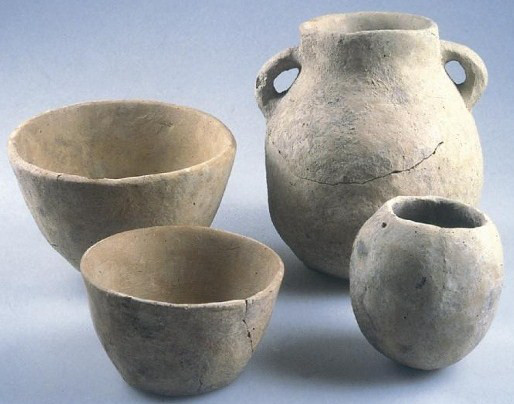
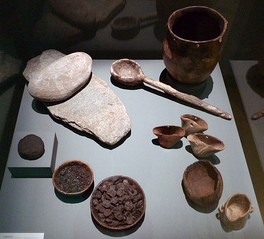
Features
- Unglazed/unburnished that is having rough surface
- Handmade coarse grey pottery
- Material – clay mixed with mica and sand
- Pottery is devoid of any painting
- In many cases twisted rice husk cords were impressed into wet clay for decoration
- Found throughout India including the South. Burzahom – coarse grey pottery
- Included black-burnished ware, greyware and mat-pressed ware
II. Chalcolithic Age
Chalcolithic Era, the first metal age, is marked by the occurrence of distinct cultures in various parts of our country namely – Ahar culture in South Eastern Rajasthan, Malwa culture in Western MP, Jorwe culture in Western Maharashtra, etc.
People of this age used different kinds of pottery.
1. Black-and-red-ware Pottery
Black and red ware seems to have been widely used. Cultures like Ahar-Banas showed the presence of Black and Red ware pottery with white linear designs.
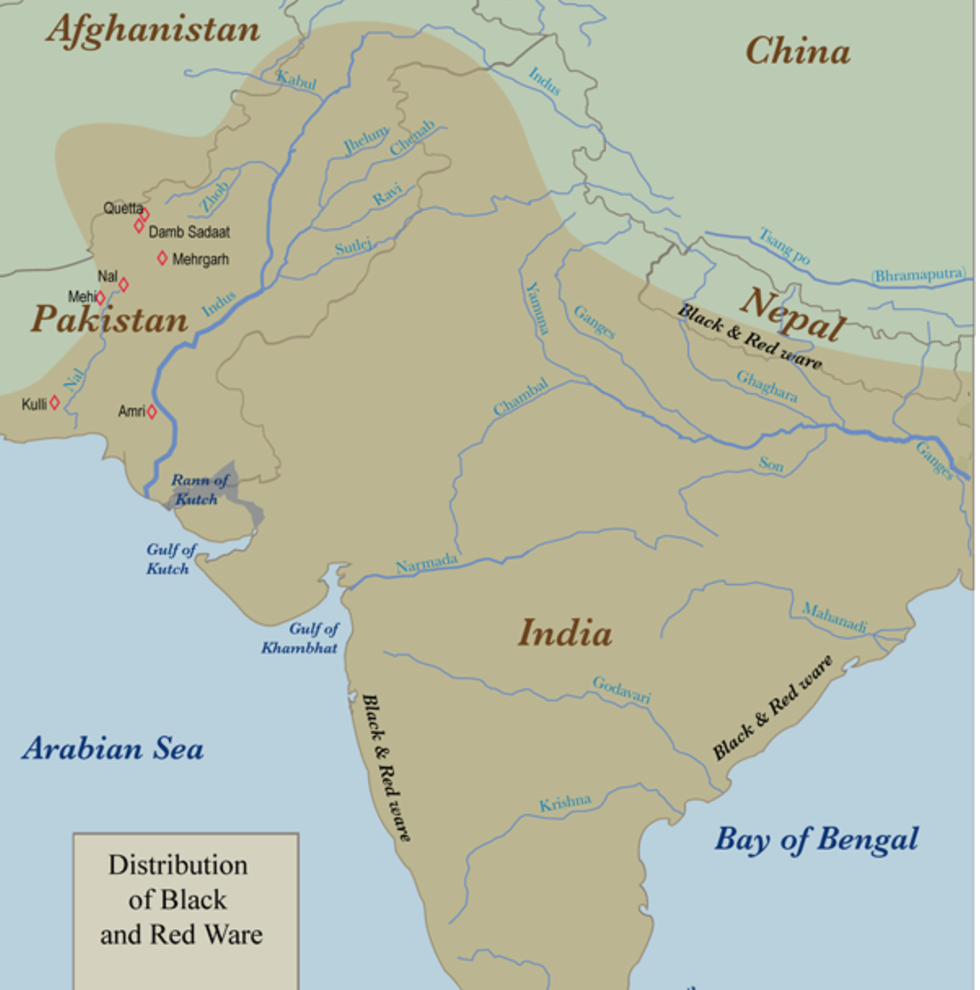
This pottery is identified with the Copper Hoard Culture that was found in upper Ganga Valley and Ganga Yamuna doab area.
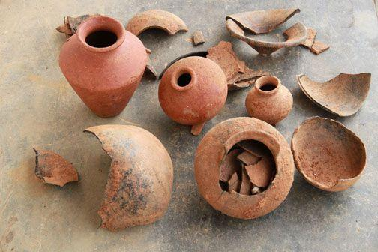
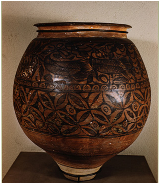
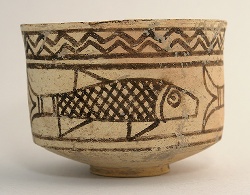
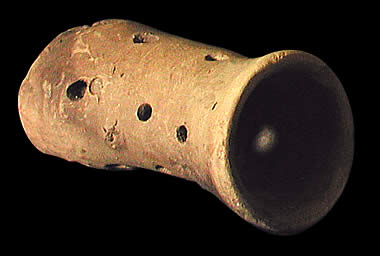
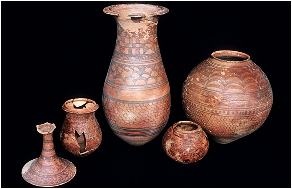
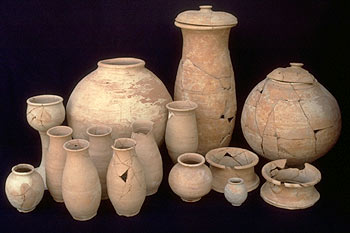
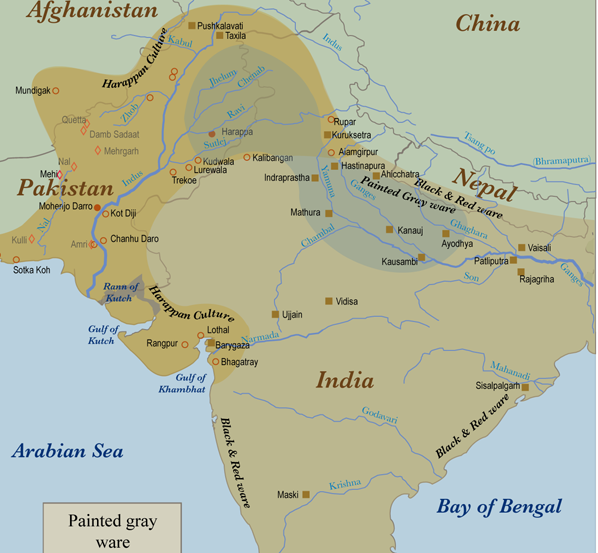
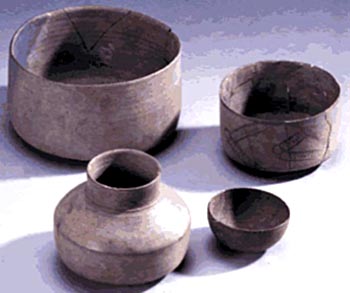
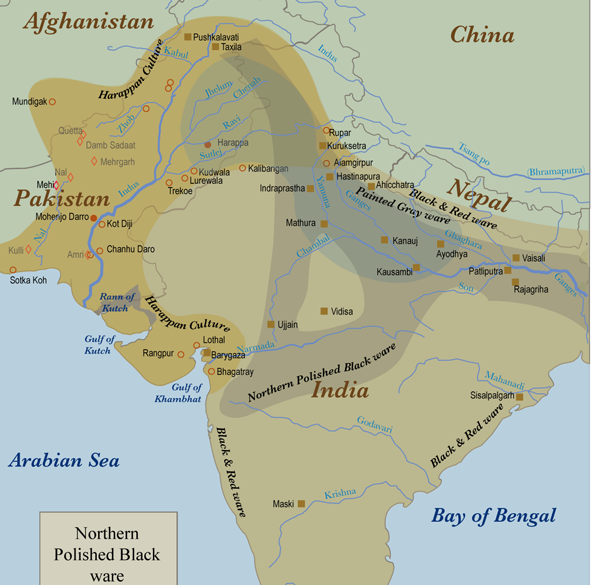
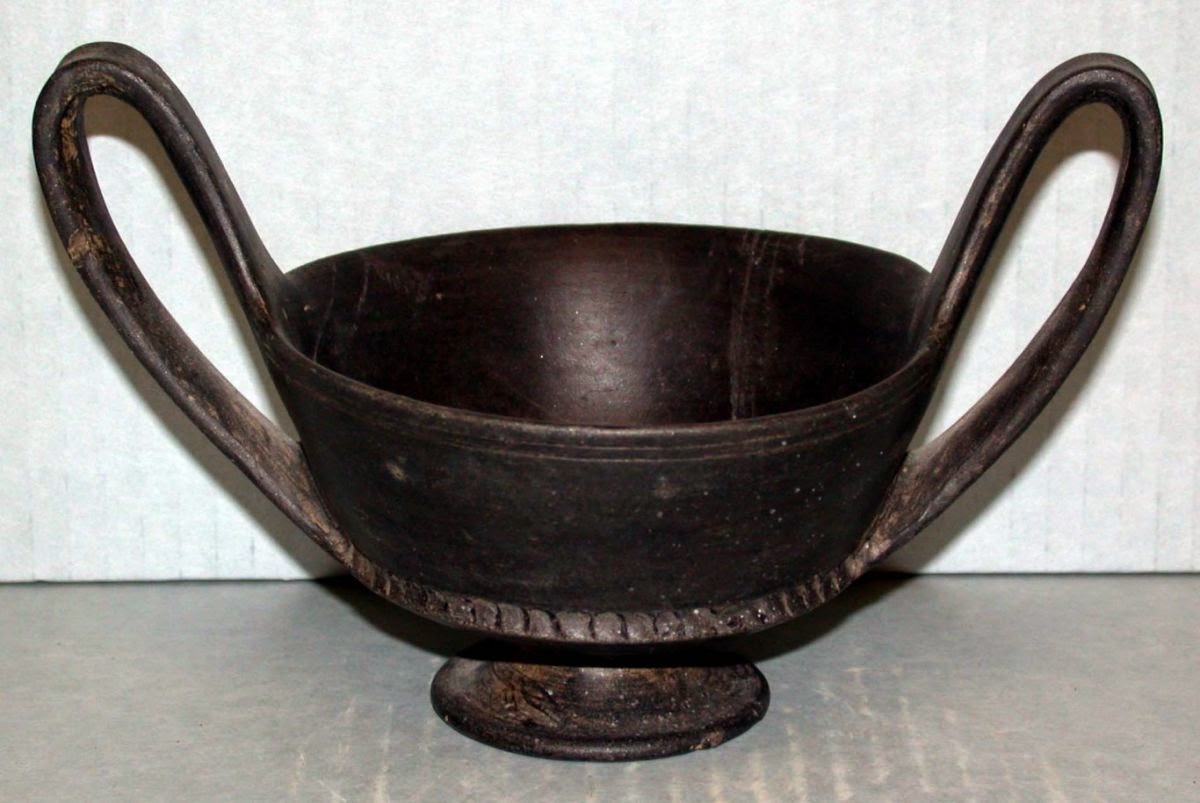
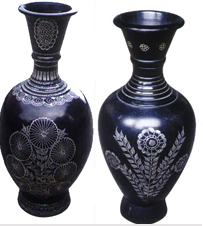
This culture is placed between- 3rd Century BC to 1st Century AD. Megaliths refers to monuments constructed of big (mega) stones (lith). This culture is particularly known for its large stone graves. In the South this age is characterized by the use of iron.
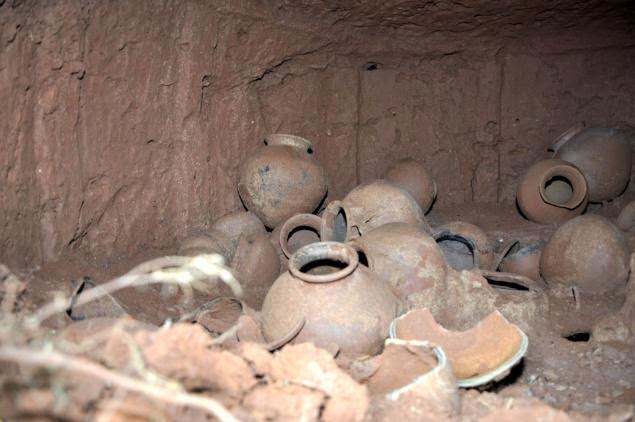
Pottery – Evolution and significance
- Pottery or ceramics or ceramic art refers to the creation of objects that are made up of hard brittle material produced from non-metallic minerals by moulding them while the material is wet and then firing them at high temperatures. They are often made up of clay, porcelain, steatite, etc.
- Pottery plays an important role in studying culture and reconstructing the past. Historically with distinct culture, the style of pottery changed. It reflects the social, economic and environmental conditions a culture thrived in, which helps the archaeologists and historians in understanding our past. It holds significant value in understanding cultures where script was either absent or remains undeciphered. Understanding of presence of fire, cooking, storage, sedentary or migratory populace, social stratification can all be developed via studying pottery.
- For people, pottery provided opportunity to store, cook, transport, trade and essentially became an expression of artistic creativity.
- Pottery is majorly of two types
- Handmade
- Wheel thrown
- Handmade pottery is rather a primitive style pottery developed in early ages which with time transforms to wheel thrown. The different motifs drawn on the surface plays an important role in understanding a culture and its beliefs.
Evolution of Pottery
- I. Neolithic Age
- We find the first reference of pottery in this age. Naturally it is hand-made pottery but during the later period footwheel is also used.


- Features
- Unglazed/unburnished that is having rough surface
- Handmade coarse grey pottery
- Material – clay mixed with mica and sand
- Pottery is devoid of any painting
- In many cases twisted rice husk cords were impressed into wet clay for decoration
- Found throughout India including the South. Burzahom – coarse grey pottery
- Included black-burnished ware, greyware and mat-pressed ware
- II. Chalcolithic Age
- Chalcolithic Era, the first metal age, is marked by the occurrence of distinct cultures in various parts of our country namely – Ahar culture in South Eastern Rajasthan, Malwa culture in Western MP, Jorwe culture in Western Maharashtra, etc.
- People of this age used different kinds of pottery.
- 1. Black-and-red-ware Pottery
- Black and red ware seems to have been widely used. Cultures like Ahar-Banas showed the presence of Black and Red ware pottery with white linear designs.













Neanderthal phylogenetic status 1 |
Neanderthal has phylogenetic status. Discuss in ember and ember 2016.
Fully bipedalism. did not look different from modern humans despite their sloping foreheads, large browridges, flat and brain case, large jaw and nearly absent chin. They had large brain than humans. 1450 cc.
40000 year ago ancestors of Europe have many common features with neanderthals but do not have projecting bid face as much.
1977 us and Germany study. Mitochondrial DNA study. 25 differences which is three times the difference between modern humans. This suggested that they must have diverged 600000 the go. Krings 1997. Chimpanzees have 55 differences.
another difference from homosapiens. Do not have sophisticated tool Technology. Humans have better tools at the same time.
Neanderthals do not have microcephalin gene that is associated with brain development. Pennisi 2009.
Similarity. Identical foxp2 gene mutations. Capacity for language. Indian Russell infants had the same feature that human infants by the age of 10.
But many genes in humans are common with neanderthals which means our evolution is not linear but multilinear as argued by christophe singer.
Tool tech 1 |
Tool tech
- Paleolithic
- Core tool. Lower
- Chopper chopping cleaver and handaxe
- Chopper is unifacial with broad cutting-edge and thick pebble butt
- Chopping tool with bifacial flaked and thick pebble butt.
- hand X shape bifacial pear faced triangular ovate.
- Cleaver. Broad edge bifacial tool.
- Flake tool. Middle
- Bora points and scraper. Triangular points in mousterian.
- side scraper end scraper round scraper
- Blade. Upper.
- Blades burins. Laurel lead points. Pressure flaking technique in solutrean industry.
- Blades are long and thin parallel sided flake with a mid ridge.
- Mesolithic.
- microlithic tools. Geometric trapeze rectangular triangular composite tools
- Neolithic.
- Neolithic celts. Chisels. Ringstone and querns.
- Chisel carpentry.
- Querns. Grinding and processing grains.
Ethnoarchaeology |
- Ray found that sitharia caste practices a brass working in an indigenous style which is remarkably similar to brass artefacts found at Kuanr.
- N Athiyaman 1998. Studied quarrying techniques in Tamilnadu Uttukuli to reconstruct megalithic sites of South India. Focusing on there Sourcing of stones, quarrying, transportation and architecture.
- Carla Sinopoli. 1991. Seeking the past through the present.
- Since 1960 astrology has studied contemporary societies for archaeology and focused on topics like
- Site formation and depositional processes
- Documentation of traditional Technologies community forms and settlement patterns
- Relation of humans and environment
- Study of material implications of social systems ideologies and beliefs
- Hoddor 1979. Ethnoarchaeology has shown us Human behaviour is complex and diverse.
- So we cannot make generalisation from a single case.
- South Asia. Particularly India is full of diversity and wealth of data to study the past. But we should not view India as time less and static. Like every culture Indian tribes and culture is also changing.
- Allchin 1985. material parallels do not unequivocally demonstrate social cultural and behavioral parallels. There may not be any historic continuity as well.
- ethnoarchaeology does not provide a blueprint to the past but a Framework for understanding material consequences of behaviour and technologies. Also documenting diversity and regularity is in human behaviour.
- South Asian anthro archaeology Studies four categories
- Traditional subsistence and settlement strategies
- Primary focus on hunter gatherer populations. Studies by Murty 1978. Raju 1988. Nagar 1975,1985 in Madhya Pradesh. Cooper in Andaman 1985. Paddya 1982.
- studied the subsistence resources and patterns of seasonal movement and Technology. Mishra 1974.
- this information is applied in understanding archaeological remains in the same region. In India there is lack of stratified validated primary context site and near absence of preserved formal and Botanical remains. Therefore ethnoarchaeology is very helpful.
- But today is Ecology is not the same as thousands of years ago. Many wild plants and animals have vanished whereas forests have changed due to agriculture.
- Murty 1981 has noted broad knowledge among members for their natural environment and most groups traditionally expected very wide range of plant and animal resources. Paddya observed in 1982, settlement system was responsive to seasonal availability of food and water.
- Murty has noted the symbiotic relation between tribal population and sedentary agriculturists in Andhra Pradesh. Tribals provide wood Honey fibre in exchange for Agricultural Products and crafts. It allows us to understand how during the pre history when agriculture was beginning, how tribals and agriculturalists interacted.
- Roy 1981 studied Assam. focus on technological and social aspects of shifting agriculture in the Garo Hills. he found out that all the excess and who's used by modern agricultural list were made of metal but their wear and Tear pattern was quite similar to the Prehistoric stone tools found in the same region. he also studied impact of environmental constraints on labour investment and coordination and seasonal variations in agricultural activities.
- Roy also documented indigenous folktales on the origin of modern agriculture and how cereal crops were introduced in their traditional system of fruit crop cultivation.
- Murty and Sontheimer 1980 documented birappa legends of kuruva pastoralists of Andhra Pradesh and Karnataka to understand the Origins of pastoralism in third Millennium BC.
- House forms also studied
- Traditional Technologies and Organisation of craft production
- Potter's stone workers metal casters we was still exist in South Asia thereby allowing anthro archaeologists to study them.
- studies showed social relations between Producers and Consumers, distribution and exchange systems. Which could explain archaeological distribution of materials.
- Saraswati 1978. concluded that there was long-term continuity in traditions of pottery between north India from Harappa times till present. therefore modern potters are direct descendants of protohistoric or pre-historic potters.
- Social organisation and belief systems
- Formation of archaeological sites
Read when jstor account works.
Deccan School contribution. Read and extract studies.